

SIMON PETER ENGURAIT

A $100M+ Investment in Your Well-Being
Sports Complex – Built to NCAA standards; includes a multi-purpose field with 8-lane track, tennis courts, beach volleyball and outdoor basketball court.
Fitness Center – State-of-the-art facility equipped with the latest technology and programs, aquatics, gymnasium and more; Certified and a top-ranked facility in the nation by the Medical Fitness Association; More than 1M visits since opening.
Playground & Education Initiative – Addressing childhood obesity through nutrition education and new playground equipment for numerous area elementary schools.
Sports – Keeping athletes safe by providing athletic trainers in high schools as well as Nicholls State University; Helping athletes grow and excel in sports through formation of competitive youth volleyball and swim teams.
Wellness Education – Numerous and expanding programs for individuals and families on subjects like nutrition, weight management, diabetes, CPR and more.
WellFit – Integrating wellness into clinical care to address specific health conditions like cancer, orthopaedic conditions, chronic pain and diabetes.





THE OFFICIAL MAGAZINE OF THE DIOCESE OF HOUMA-THIBODAUX
OUR NEW BISHOPCATHOLIC LIVING
4 THE FIRST PASTORAL LETTER FROM BISHOP SIMON PETER
12 FROM THE NILE TO THE BAYOU:
A Personal History of Bishop

FALL 2025 VOLUME 46 NO. 6
BISHOP
Most Rev. Simon Peter Engurait
DIRECTOR OF COMMUNICATIONS AND PUBLIC RELATIONS
Bevi Fontenot
EDITOR
Joe O’Sullivan
DESIGNER
Alaina Maiorana
COVER DESIGNER
Connor Mabile
BUSINESS MANAGER
Bill Barbera
ACCOUNTING SPECIALIST
Rebecca Thibodeaux
CONTRIBUTING WRITERS
George Edward Olokojo
Sr. Salome Mary Aguti
Keely Diebold
More Than Entertained Team
PHOTOGRAPHERS
Serdave Duncan
Angeljoy Porche
EMAIL US: communications@htdiocese.org VISIT US ONLINE bayoucatholic.org
Simon Peter
20 A CONVERSATION WITH BISHOP-ELECT SIMON PETER
26 UNITING CONTINENTS
A Charismatic Prayer Service
30 THE NIGHT BEFORE THE DAWN
Solemn Vespers Ushers in a New Chapter
34 THE ORDINATION AND INSTALLATION OF BISHOP SIMON PETER ENGURAIT
The Diocese of HoumaThibodaux Officially Welcomes its Sixth Bishop
44 A WEEKEND OF CELEBRATION AND GRATITUDE
Bishop’s Masses of Thanksgiving
50 CONGRATULATORY MESSAGES FOR BISHOP SIMON PETER
52 IN DEO TANTUM
The Significance of the Coat of Arms
55 SACRED SIGNS
The Symbols of a Bishop
58 MY UNCLE, THE BISHOP
Through the Eyes of a Nephew
62 FROM SOROTI TO HOUMATHIBODAUX
The Making of a Bishop
70 KIDS SHOW LOVE TO OUR BISHOP
78 NEW PRIESTS IN HOUMA-THIBODAUX
80 OUR NEWEST SEMINARIANS
82 PRAYER AND LITURGICAL CALENDARS
October
84 IN MEMORY OF FR. ROGER VILLARRUBIA, JR.
85 MEET OUR NEWEST SAINTS
Saints Carlo Acutis and Pier Giorgio Frassati
88 HOW TO RECEIVE A PLENARY INDULGENCE
91 DIOCESAN EVENT RECAPS
96 FAITH LIKE A CHILD
A Mother’s Journey to Becoming Catholic
100 VETERANS DAY A Legacy of Service, Courage, and Faith 104 ALL SAINTS AND ALL SOULS REFLECTION 106 THEOLOGY ON TAP A Ministry for Young Professionals 108 MORE THAN ENTERTAINED The Lion King 112 HEAVENLY RECIPES
Chapati Bread 117 UPCOMING EVENTS

THE FIRST PASTORAL LETTER FROM BISHOP SIMON PETER
A SHEPHERD’S VISION FOR HOUMA-THIBODAUX

My dear brothers and sisters in Christ, Peace be with you!
In his fist letter to the Corinthian Church, St. Paul describes the good things that God has in store for us as that which “no eye has seen, nor ear heard, nor the heart of man conceived” (1 Cor 2:9). In the same way, words cannot describe the experience of the events surrounding my ordination and installation as your bishop. What I experienced was not simply an event for me personally, but a powerful outpouring of love and faith from the whole diocese. The prayers, the music, the hospitality, and the joy that filled those days were a testimony to the strength of this local Church, and the power of what I experienced is both overwhelming and consoling. It makes palpable the words that I often begin my homilies with: “God is good all the time, and all the time, God is good!” I am deeply grateful to all of you—clergy, religious, families, parishioners, young people—for the countless ways you surrounded me with support and prayer. Thank you for supporting me with such warmth and generosity.
As we embark now on this new chapter together, I see the lens of my episcopal ministry through my experience as a pastor. The Lord has called me to serve you, to walk with you, and to help you encounter more deeply the love and saving presence of Jesus Christ. My years as a parish priest, most recently as pastor of St. Bridget, have taught me that shepherding God’s people begins with listening, with being present, and with trusting that God is always at work, even when the path is not clear. While I do take up the role of shepherd of this diocese, my role is to always lead and point to the real shepherd, the Good Shepherd. He is the one who has been leading our diocese through the many trials of the last five years. He has never and will never abandon us but will always be faithful. This is how I wish to lead you: not with my own strength, but by placing all of us in the hands of the God who never fails us. As is written in the book of Exodus, “the Lord will fight for you; you have only to be still” (Exodus 14:14). With the Lord, we cannot fail, and so together we follow him.
As I begin this new ministry and ponder how the Lord will use my own episcopal ministry, I cannot help but think of the bishops who came before me and the many important lessons that I have personally learned from each of them whom I have had the privilege to serve and work with. Bishop Jacobs impacted me by the power of his deep prayer life, remaining unwaveringly devoted to prayer amid his work through daily adoration, and his boldness in proclaiming the Gospel. Bishop Fabre showed me the importance of listening carefully and discerning wisely, and I learned much from his collaborative and visionary leadership. Bishop Dorsonville brought a joyful and personal presence that touched so many hearts even in his short time with us. Their examples encourage and inspire me, and I pray I may carry forward the best of what they gave to me and to all of us, while also listening to what the Holy Spirit is asking of us now.
In prayer, I believe the Lord is inviting us to focus together on a few priorities that are close to my heart:
Marriage and Family Life. Strong marriages form the foundation of strong families, and strong families give life to the Church. I hope we can walk with couples—those preparing for marriage, those celebrating many years together, and those facing struggles—so that the love of Christ can be at the center of every home. We will never have a strong Church if we do not have strong families.
Youth and Young People. Our children and youth are not just “the future of the Church”—they are an essential part of the Church today. I want us to be very intentional in helping our young people encounter Jesus personally, whether in our parishes, schools, or other ministries. A young heart touched by Christ becomes a witness the world cannot ignore.
Care for the Marginalized and Less Fortunate. We can never forget that Jesus had a particular concern for the poor—whether spiritually, materially, or socially. Pope Francis always called us to go to the fringes of society, to expand our horizons and move out of our comfort zones. We must never stop reaching out to the less fortunate and marginalized in our society, both across the world and within our own communities.
Preaching and Teaching the Gospel. As your bishop, one of my greatest responsibilities is to proclaim the Good News of Jesus Christ clearly and lovingly. In fact, in praying with the Rite of Ordination during my retreat, I was struck that one of the preeminent roles of the bishop is preaching and teaching! Our times can feel uncertain, even fearful, but God is always faithful. I want us to grow together in trust, allowing His Word to strengthen and guide us. I pray that God would allow me to be a worthy and effective instrument in His hands.
My friends, I do not come to you with all the answers to our many challenges. I simply come with a heart ready to listen, to learn, and to walk beside you. I look forward to what God has in store for us in this next chapter. Together, with great faith and trust in our God, we can build up the Body of Christ here in Houma-Thibodaux.
Please continue to pray for me. I promise to pray for you each day. Let us daily place our lives and our entire diocese under the loving care of Mary, our Mother, asking her to intercede for us as we take these fist steps together.
May God bless you and your families this day and every day.
“ THE LORD HAS CALLED ME TO SERVE YOU, TO WALK WITH YOU, AND TO HELP YOU ENCOUNTER MORE DEEPLY THE LOVE AND SAVING PRESENCE OF JESUS CHRIST.
”

LA PRIMERA CARTA PASTORAL DEL OBISPO SIMÓN PETER ENGURAIT
LA
VISIÓN DE UN PASTOR PARA HOUMA-THIBODAUX
Mis queridos hermanos y hermanas en Cristo:
¡La paz sea con ustedes!
En su primera carta a la Iglesia de Corinto, San Pablo describe las cosas buenas que Dios tiene reservadas para nosotros como aquello que «ningún ojo ha visto, ningún oído ha oído, ni el corazón del hombre ha concebido» (1 Cor 2, 9). Del mismo modo, no hay palabras para describir la experiencia de los acontecimientos que rodearon mi ordenación y toma de posesión como obispo. Lo que viví no fue simplemente un acontecimiento personal, sino una poderosa manifestación de amor y fe por parte de toda la diócesis. Las oraciones, la música, la hospitalidad y la alegría que llenaron esos días fueron un testimonio de la fortaleza de esta Iglesia local, y la fuerza de lo que experimenté es a la vez abrumadora y consoladora. Hace palpables las palabras con las que a menudo comienzo mis homilías: «Dios es bueno todo el tiempo, y todo el tiempo, Dios es bueno». Estoy profundamente agradecido a todos ustedes — clero, religiosos, familias, feligreses, jóvenes— por las innumerables formas en que me rodearon con su apoyo y sus oraciones. Gracias por apoyarme con tanta calidez y generosidad.
Ahora que nos embarcamos juntos en este nuevo capítulo, veo la perspectiva de mi ministerio episcopal a través de mi experiencia como párroco. El Señor me ha llamado a servirles, a caminar con ustedes y a ayudarles a encontrar más profundamente el amor y la presencia salvadora de Jesucristo. Mis años como párroco, más recientemente como pastor de Santa Brígida, me han enseñado que pastorear al pueblo de Dios comienza por escuchar, estar presente y confiar en que Dios siempre está obrando, incluso cuando el camino no está claro. Aunque asumo el papel de pastor de esta diócesis, mi función es siempre guiar y señalar al verdadero pastor, el Buen Pastor. Él es quien ha estado guiando a nuestra diócesis a través de las muchas pruebas de los últimos cinco años. Nunca nos ha abandonado ni lo hará, sino que siempre será fiel. Así es como deseo guiarlos: no con mi propia
fuerza, sino poniéndonos a todos en manos del Dios que nunca nos falla. Como está escrito en el libro del Éxodo: «El Señor peleará por ustedes; solo tienen que estar tranquilos» (Éxodo 14, 14). Con el Señor, no podemos fallar, así que juntos lo seguimos.
Al comenzar este nuevo ministerio y reflexionar sobre cómo el Señor utilizará mi propio ministerio episcopal, no puedo evitar pensar en los obispos que me precedieron y en las muchas lecciones importantes que he aprendido personalmente de cada uno de ellos, con quienes he tenido el privilegio de servir y trabajar. El obispo Jacobs me impactó por el poder de su profunda vida de oración, permaneciendo inquebrantablemente dedicado a la oración en medio de su trabajo a través de la adoración diaria, y su audacia en la proclamación del Evangelio. El obispo Fabre me mostró la importancia de escuchar con atención y discernir con sabiduría, y aprendí mucho de su liderazgo colaborativo y visionario. El obispo Dorsonville aportó una presencia alegre y personal que tocó muchos corazones, incluso en el poco tiempo que estuvo con nosotros. Sus ejemplos me animan y me inspiran, y rezo para poder llevar adelante lo mejor de lo que nos dieron a mí y a todos nosotros, al tiempo que escucho lo que el Espíritu Santo nos pide ahora.
En la oración, creo que el Señor nos invita a centrarnos juntos en algunas prioridades que están cerca de mi corazón:
Matrimonio y vida familiar. Los matrimonios sólidos son la base de familias sólidas, y las familias sólidas dan vida a la Iglesia. Espero que podamos acompañar a las parejas —las que se preparan para el matrimonio, las que celebran muchos años juntas y las que enfrentan dificultades— para que el amor de Cristo pueda estar en el centro de cada hogar. Nunca tendremos una Iglesia sólida si no tenemos familias sólidas.
Juventud y jóvenes. Nuestros niños y jóvenes no son solo «el futuro de la Iglesia», sino que son una parte

esencial de la Iglesia actual. Quiero que nos esforcemos por ayudar a nuestros jóvenes a encontrar a Jesús personalmente, ya sea en nuestras parroquias, escuelas u otros ministerios. Un corazón joven tocado por Cristo se convierte en un testigo que el mundo no puede ignorar.
Cuidar a los marginados y menos afortunados. Nunca podemos olvidar que Jesús tenía una preocupación especial por los pobres, ya fuera espiritual, material o socialmente. El papa Francisco siempre nos ha llamado a ir a los márgenes de la sociedad, a ampliar nuestros horizontes y salir de nuestra zona de confort. Todos nosotros debemos seguir tendiendo la mano a los menos afortunados y marginados de nuestra sociedad, tanto en todo el mundo como en nuestras propias comunidades.
Predicar y enseñar el Evangelio. Como su obispo, una de mis mayores responsabilidades es proclamar la Buena Nueva de Jesucristo con claridad y amor. De hecho, al rezar con el Rito de la Ordenación durante mi retiro, me llamó la atención que una de las funciones más destacadas del obispo es predicar y enseñar. Nuestros tiempos pueden parecer inciertos, incluso temibles, pero
Dios siempre es fiel. Quiero que crezcamos juntos en la confianza, permitiendo que Su Palabra nos fortalezca y nos guíe. Rezo para que Dios me permita ser un instrumento digno y eficaz en Sus manos.
Amigos míos, no vengo con todas las respuestas a nuestros numerosos retos. Simplemente vengo con un corazón dispuesto a escuchar, a aprender y a caminar junto a ustedes. Espero con ilusión lo que Dios nos tiene reservado en este nuevo capítulo. Juntos, con gran fe y confianza en nuestro Dios, podemos edificar el Cuerpo de Cristo aquí, en Houma-Thibodaux.
Por favor, sigan orando por mí. Prometo orar por ustedes cada día. Pongamos diariamente nuestras vidas y toda nuestra diócesis bajo el amoroso cuidado de María, nuestra Madre, pidiéndole que interceda por nosotros mientras damos estos primeros pasos juntos.
Que Dios los bendiga a ustedes y a sus familias hoy y todos los días.
LÁ THƯ MỤC VỤ ĐẦU TIÊN CỦA ĐỨC
CHA SIMON PETER ENGURAIT
MỘT VIỄN TƯỢNG CỦA VỊ CHỦ CHĂN CHO HOUMA-THIBODAUX
Anh chị em thân mến trong Chúa Kitô,
Bình an của Chúa ở cùng anh chị em!
Trong thơ thứ nhất gửi tín hữu Côrintô, Thánh Phaolô đã mô tả những điều tốt đẹp mà Thiên Chúa dành sẵn cho chúng ta như những điều “mắt chẳng hề thấy, tai
chẳng hề nghe, lòng người không hề nghĩ tới” (1Cor 2:9). Cũng vậy, không lời nào có thể diễn tả hết những trải nghiệm của tôi về các sự kiện liên quan đến lễ tấn phong và bổ nhiệm tôi làm giám mục của anh chị em. Những gì tôi trải qua không chỉ đơn thuần là một sự kiện đối với cá nhân tôi, mà còn là một làn sóng tình yêu và đức tin mạnh mẽ từ toàn thể giáo phận. Những lời cầu nguyện, thánh nhạc, lòng hiếu khách và niềm vui tràn ngập những ngày đó là minh chứng cho sức mạnh của Giáo Hội địa phương này, và sức mạnh của những gì tôi trải qua vừa tràn ngập vừa an ủi. Điều đó làm cho những lời tôi thường bắt đầu bài giảng của mình trở nên rõ ràng: “Thiên Chúa luôn tốt lành, và Thiên Chúa luôn tốt lành!” Tôi vô cùng biết ơn tất cả anh chị em - các giáo sĩ, tu sĩ, gia đình, giáo dân, và giới trẻ - vì số lượng anh chị em không thể đếm được, đã bao quanh tôi bằng sự hỗ trợ và lời cầu nguyện. Cảm ơn anh chị em đã hỗ trợ tôi bằng sự nồng nhiệt và tốt lành như vậy.
Khi chúng ta cùng nhau bước vào trang sử mới này, tôi nhìn thấy lăng kính của chức vụ giám mục của mình qua kinh nghiệm của một mục tử. Chúa đã gọi tôi để phục vụ anh chị em, để đồng hành với anh chị em và giúp anh chị em gặp gỡ sâu sắc hơn tình yêu và sự hiện diện cứu độ của Chúa Giêsu Kitô. Những năm tháng làm linh mục chánh xứ, gần đây nhất là cha xứ của giáo xứ thánh Bridget, đã dạy tôi rằng việc chăn dắt dân Chúa bắt đầu bằng việc lắng nghe, bằng sự hiện diện và tin tưởng rằng Chúa luôn hoạt động, ngay cả khi con đường không rõ ràng. Trong khi tôi đảm nhận vai trò là mục tử của giáo phận này, vai trò của tôi là luôn dẫn dắt và chỉ đến người mục tử thực sự, Người Mục tử tốt lành. Ngài là người đã dẫn dắt giáo phận của chúng ta vượt qua nhiều thử thách trong năm năm qua. Ngài chưa bao giờ và sẽ không bao giờ bỏ rơi chúng ta nhưng sẽ luôn trung thành. Đây là cách tôi
muốn dẫn dắt anh chị em: không phải bằng sức mạnh của riêng tôi, nhưng bằng cách đặt tất cả chúng ta vào bàn tay Thiên Chúa, Đấng không bao giờ làm chúng ta thất vọng. Như đã chép trong sách Xuất Hành, “Đức Chúa sẽ chiến đấu cho anh em; anh em chỉ có việc ngồi yên” (Xh 14:14). Với Đức Chúa, chúng ta không thể thất bại, và vì vậy, chúng ta cùng nhau bước theo Ngài.
Khi bắt đầu sứ vụ mới này và suy ngẫm về cách Chúa sẽ sử dụng chức giám mục của tôi, tôi không khỏi nghĩ đến các vị giám mục tiền nhiệm và nhiều bài học quan trọng mà tôi đã học được từ mỗi vị, những người mà tôi có vinh dự được phục vụ và làm việc cùng. Đức cha Jacobs đã tác động đến tôi bởi sức mạnh của đời sống cầu nguyện sâu sắc, luôn kiên trì cầu nguyện giữa công việc thờ phượng hằng ngày, và sự hùng mạnh trong việc rao giảng Phúc Âm. Đức Cha Fabre đã cho tôi thấy tầm quan trọng của việc lắng nghe cẩn thận và phân định khôn ngoan, và tôi đã học được nhiều điều từ sự lãnh đạo hợp tác và có tầm nhìn xa của ngài. Đức cha Dorsonville đã mang đến một sự hiện diện vui tươi và gần gũi, chạm đến biết bao trái tim dù chỉ trong thời gian ngắn ngủi ngài ở cùng chúng ta. Những tấm gương của các giám mục khích lệ và truyền cảm hứng cho tôi, và tôi cầu nguyện rằng tôi có thể chuyển tiếp những điều tốt đẹp nhất mà các ngài đã dành cho tôi và cho tất cả chúng ta, đồng thời lắng nghe những gì Chúa Thánh Thần đang kêu gọi chúng ta lúc này.
Trong lời cầu nguyện, tôi tin rằng Chúa đang mời gọi chúng ta cùng nhau tập trung vào một số ưu tiên mà tôi tâm đắc nhất:
Hôn nhân và Đời sống Gia đình. Hôn nhân bền vững tạo nên nền tảng cho những gia đình vững mạnh, và những gia đình vững mạnh mang lại sức sống cho Giáo hội. Tôi hy vọng chúng ta có thể đồng hành cùng các cặp vợ chồng - những người đang chuẩn bị kết hôn, những người đang kỷ niệm nhiều năm hôn phối bên nhau, và những người đang đối mặt với khó khăn - để tình yêu của Chúa Kitô có thể là trung tâm của mọi mái ấm gia đình. Chúng ta sẽ không bao giờ có
một Giáo hội vững mạnh nếu không có những gia đình vững chắc.
Giới trẻ và Người trẻ. Con cái và người trẻ của chúng ta không chỉ là “tương lai của Giáo hội” mà còn là một phần thiết yếu của Giáo hội ngày nay. Tôi muốn chúng ta hết sức chủ động giúp đỡ những người trẻ gặp gỡ Chúa Giêsu cách cá nhân, dù là trong giáo xứ, trường học hay các mục vụ khác. Một trái tim trẻ thơ được Chúa Kitô chạm đến sẽ trở thành một chứng nhân mà thế giới không thể bỏ qua.
Chăm sóc những người thiệt thòi và kém may mắn. Chúng ta không bao giờ được quên rằng Chúa Giêsu đã đặc biệt quan tâm đến người nghèo - dù là về mặt tinh thần, vật chất hay xã hội. Đức Giáo hoàng Phanxicô luôn kêu gọi chúng ta đến với những vùng ngoại vi của xã hội, mở rộng tầm nhìn và bước ra khỏi vùng an toàn của mình. Chúng ta không bao giờ được ngừng vươn tới những người kém may mắn và kém may mắn trong xã hội, cả trên toàn thế giới và trong chính cộng đồng của chúng ta.
Rao giảng và Giảng dạy Phúc Âm. Là giám mục của anh chị em, một trong những trách nhiệm lớn nhất của tôi là công bố Tin Mừng của Chúa Giêsu Kitô một cách rõ ràng và yêu thương. Thực tế, khi cầu nguyện với Nghi thức Truyền chức trong kỳ tĩnh tâm, tôi đã nhận ra rằng một trong những vai trò quan trọng nhất của giám mục chính là rao giảng và giảng dạy! Thời đại của chúng ta có thể đầy bất ổn, thậm chí là sợ hãi, nhưng Thiên Chúa luôn trung tín. Tôi muốn chúng ta cùng nhau lớn lên trong niềm tin tưởng, để Lời Ngài củng cố và dẫn dắt chúng ta. Tôi cầu xin Chúa cho tôi trở thành một khí cụ xứng đáng và hữu hiệu trong tay Ngài.
Anh chị em thân mến, tôi không đến với anh chị em với tất cả câu trả lời cho muôn vàn thách thức của chúng ta. Tôi chỉ đến với một tấm lòng sẵn sàng lắng nghe, học hỏi và đồng hành cùng anh chị em. Tôi mong chờ những gì Chúa dành sẵn cho chúng ta trong trang sử tiếp theo này. Cùng nhau, với đức tin và lòng tin cậy lớn lao nơi Chúa, chúng ta có thể xây dựng Thân Thể Đấng Kitô tại Houma-Thibodaux này.
Xin hãy tiếp tục cầu nguyện cho tôi. Tôi hứa sẽ cầu nguyện cho anh chị em mỗi ngày. Chúng ta hằng ngày hãy phó thác cuộc sống và toàn thể giáo phận dưới sự chăm sóc yêu thương của Đức Maria, Mẹ chúng ta, xin Mẹ chuyển cầu cho chúng ta khi chúng ta cùng nhau bước những bước đầu tiên này.
Xin Chúa ban phước lành cho anh chị em và gia đình hôm nay và mọi ngày.


FROM THE NILE TO THE BAYOU:
A PERSONAL HISTORY OF BISHOP SIMON PETER






Simon Peter Engurait was born in Ngora, located in the Eastern region of Uganda, on August 28, 1971. He is the son of the late Clement William Aeko and Crencentia Aeko, and he is the seventh of 14 children (10 girls and four boys). Four of his siblings are deceased, and he has an older sister who is a religious in the Franciscan order and an older brother who is a diocesan priest.
The family was raised in the small town of Ngora and belongs to St. Joseph’s Catholic Parish in the Diocese of Soroti. His father was a teacher by profession, specializing in the education of the deaf, while his mother was a homemaker.
After completing elementary education in Ngora, he entered St. Peter’s Minor Seminary in Soroti for junior high school, and thereafter attended St. Peters College Tororo for high school. He then entered Katigondo National Major Seminary, a college seminary, to study philosophy. Midway through his formation, he discontinued seminary studies and entered Makerere University in Kampala, where he earned a Bachelor of Arts degree, majoring in Political Science and Public Administration.
After graduating, he pursued an 11-year career with the Government of Uganda in the Department responsible for the reform and divestiture of public enterprises. During this time, he took a break to undertake graduate studies in the Netherlands where he earned a Master of Business Administration. He worked in

various departments, including human resources, procurement and business analysis, and advanced from entry level positions to management roles.
While at Katigondo Seminary, he encountered God in the movement of the Catholic Charismatic Renewal, which made a lasting impact upon his life. Later, at Makerere University, he became actively involved in this movement, serving as its Kampala Archdiocesan Leader and on its National Service team. It was through this ministry that in 2003 , he met Bishop Sam Jacobs, who would later ordain him.
In 2007 , after a long period of prayer and discernment, he was accepted as a Seminarian for the Diocese of Houma-Thibodaux and entered Notre Dame Seminary in New Orleans where he graduated with a Master of Divinity. He was ordained a deacon on May 12, 2012 at St Bernadette Church in Houma, and on May 25, 2013, he was ordained a priest at the Cathedral of St. Francis de Sales in Houma—both ordinations by Bishop Sam Jacobs.
His fist assignments were as Associate Pastor at St. Francis Cathedral for two years, followed by one year at St. Genevieve Church in Thibodaux and six months at Christ the Redeemer Church in Thibodaux. In January of 2017 , he was appointed as Administrator and later Pastor of St. Bridget Church, where he has been to present day.
Father Simon Peter has also served in various Diocesan roles. Most notably, in 2017 , Bishop Shelton Fabre appointed him as Moderator of the Curia and Coordinator of Christian Formation, and later as Vicar General for Administration. In 2023, Bishop Mario E. Dorsonville appointed him as Vicar General and Moderator of the Curia. He also served as a board member for Catholic Charities and as a member of the Presbyteral Council and College of Consultors.
Following the sudden death of Bishop Mario E. Dorsonville, he was elected to serve as Diocesan Administrator on January 22, 2024 and has continued in this role until his episcopal ordination.

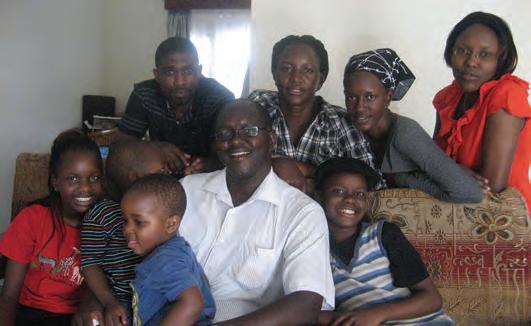


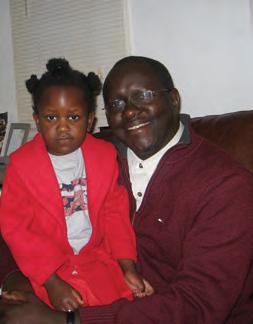


PASTORAL ASSIGNMENTS:
Administrator, then Pastor St. Bridget Catholic Church Schriever 20172025 20132015 20152016 20162017
Associate Pastor St. Francis de Sales Cathedral Houma
Associate Pastor St. Genevieve Catholic Church Thibodaux
Associate Pastor Christ the Redeemer Thibodaux





DIOCESAN ADMINISTRATION:
August 2014
August 2015
March 2016
March 2017
July 2017
September 2021
September 2023
February 2024
Appointed Assistant Vocations Director
Elected to the Presbyteral Council
Appointed Moderator of the Curia and Coordinator of Christian Formation
Appointed Vicar General for Administration
Appointed member of the College of Consultors
Appointed Interim Executive Director of Catholic Charities
Appointed Vicar General and Moderator of the Curia
Elected Diocesan Administrator




Born August 28
Ngora, Uganda
Earned Bachelor of Arts (majoring in Political Science and Public Administration) Makerere University, Kampala 1971
Graduated High School
Finished Junior High School
St. Peters Minor Seminary, Seminary Soroti
St. Peters College Tororo 1991 1992
A LOOK AT THE LIFE OF BISHOP SIMON PETER ENGURAIT
Finished Philosophical Studies Katigondo National Major Seminary





Graduated with MBA Maastricht School of Management, Netherlands 1999
2012
Ordained a Deacon St. Bernadette Church, Houma
Entered Notre Dame Seminary College New Orleans, Louisiana
2007
Graduated with Master of Divinity Notre Dame Seminary College
Ordained a Priest on May 25 St. Francis de Sales Cathedral, Houma
2013



A CONVERSATION WITH BISHOP-ELECT SIMON PETER
BY: BEVI FONTENOT AND JOE O’SULLIVAN

A week before his ordination, Bishop-Elect Simon Peter Engurait joined Diocesan Communications Director, Bevi Fontenot, and Bayou Catholic Editor, Joe O’Sullivan, for a wide-ranging conversation about his life, faith, and hopes for the future. We invite you to enjoy this behind-the-scenes glimpse of that exchange.
TELL US ABOUT WHERE YOU’RE FROM IN UGANDA AND WHAT IT WAS LIKE GROWING UP.
I was born and raised in Ngora, which is a small town in eastern Uganda. I’m one of 14 children. My father was the headmaster at the school for the deaf. Looking back, we were poor but we weren’t even aware of it. My parents were stricter than most. I had a curfew, which felt unfair as a child, but now I realize it taught us discipline and gave us rules for life. It served myself and my siblings well in life and all of us were able to go through college (and more than half of us went through graduate school). In retrospect, I saw that some of the kids who didn’t have those rules didn’t make it very far in life.
DO YOU HAVE A FAVORITE CHILDHOOD MEMORY?
Oh yes—“Ngora’s Rock!” You can look it up on Google; it’s a big mountain of rock. As kids, we would climb up and slide down using plastic cut jerrycans. Sometimes, we used banana stalks, but those wore out so fast. It was rock-sledding. Our parents told us not to do it, but you know what it’s like, the adrenaline takes over. [laughs] One day, when I was about 11 or 12 , there was an accident and a boy got knocked out. We were nervous and we knew we’d be in trouble. But he came home an hour later. The lesson we learned was to listen to your parents! [laughs]
HOW DID YOU DISCERN YOUR CALLING TO THE PRIESTHOOD?
As a child, we had priests visiting our house. They always got special treatment, and they seemed really important! I wanted to be like them. So, at a very early age, I wanted to be a priest. At 14, I entered seminary and stayed all the way through college seminary. That formation was very important for me. It introduced
discipline and a regimented life of prayer and devotion. But I felt there would be more exciting things to do in life than be a priest. [smiles] So, I went to a public university and worked for the Ugandan government for eleven years.
I had a flourishing career, but something was missing. I kept coming back to my childhood dream. Eventually, I knew the Lord was calling me to the priesthood, and I decided to re-enter the seminary.
WHAT DO YOU LOVE ABOUT THE COMMUNITY IN HOUMA-THIBODAUX?
I fist came to this country in the year 2000 , but I would mostly visit the East Coast. I always felt out of place. You know when you go to a place and you just don’t connect? I remember vividly my fist Sunday in this country. I decided to go to Mass at the Basilica of the National Shrine in Washington, DC. I wanted to greet everybody at the end of Mass but I was told not to do that! I wanted to shake hands, but people didn’t seem to want to. I was super friendly and tall, and no one seemed to want to talk to me. That was my experience. I came to DC and New York for business mostly and it was very sad—people smiled at me in the boardroom but ignored me on the metro. They had plastic smiles. That was my impression of America—a plastic life.
But when I came to Louisiana, it was a totally different world. I stayed with Bishop Jacobs and would go to events with him. One of our fist events was with deacons. I had brought a book because I knew that no one would talk to me, and I would be bored. As soon as we got there, I couldn’t read that book! [laughs] Everyone was talking to me! I connected with so many of them . The next day, people came by the bishop’s house to drop off food. That showed me how great the people are here!
The way people live here also reminds me of home. Many families all live down the same street and they can point to each other’s houses! Where I come from, it was similar. All my relatives lived within two miles of each other. So, you get it? It’s the same feel. Then, there’s the food—there are a lot of similarities to the food back home. We use onions, tomatoes and bell peppers back home in Uganda as a base, and we make a lot of stews with gravy. It’s a little different but still the same! And even the terrain is similar. From the beginning, it felt like I belonged here. I felt home.
FROM THE BEGINNING, IT FELT LIKE I BELONGED HERE. I FELT HOME. ” “
YOU’VE SERVED UNDER SEVERAL OF OUR BISHOPS. WHAT DID YOU LEARN FROM THEM?
What I admire about Bishop Jacobs is his prayer life. It was amazing. I lived with him for a year and just watched him pray. When he would get back from the chancery every day, he would go into the chapel right away to pray. He would also go to adoration fist thing in the morning. No matter what, he was there. I really admired his preaching, too, especially his altar calls. He was bold and he challenged people to give their lives to Jesus. He was so dynamic!
Bishop Fabre taught me about both gentleness and firmess. He had a consultative, collaborative approach to ministry and decision-making. He had deep discernment and vision for the diocese; he was a visionary leader!
Bishop Mario—the thing that I admired about him most was his joy! He had conviction, and if he wanted to do something, just get out of his way [laughs]. But he also made you feel like you were the only person in the room.
WHAT KIND OF BISHOP DO YOU HOPE TO BE?
I believe the Lord is calling me to be a pastor—to lead people to the love and saving presence of God by bringing my experience at St. Bridget to the broader church. I can apply what I learned there to the diocese as a whole.
At St. Bridget, I invested a lot of time in preparing couples for marriage, because the marital covenant is the foundation to family life. Where you have strong families, you have strong communities. I want to see more intentional ministry to families across our diocese.
I also want to focus on the formation of young people, both in our schools and parishes. We have good tools already, but I want to see us use them more fully.
And I want to continue outreach to the poor and vulnerable, which the Rite of Ordination for bishops says explicitly. That call struck me: to preach and teach to all, especially strangers and outsiders.
HOW CAN WE FOSTER UNITY AMONG ALL CHRISTIANS?
One of the greatest scandals is the divisions in the Body of Christ. Jesus himself prayed that they may be one as we are one. So, working towards Christian unity is very, very

THERE ARE SO MANY THINGS THAT UNITE US AND VERY FEW THAT DIVIDE US. “
SO WHY DON’T WE BEGIN FROM THERE? ”

important. And it begins with recognizing the things that unite us. There are so many things that unite us and very few that divide us. So why don’t we begin from there?
It’s [important] to recognize where people are in their lives and acknowledge our common humanity. For us as Catholics, we have the dignity of every human person enshrined in our doctrines.
One of my desires has been to strengthen outreach in parish communities. At St. Bridget, we formed the St. Vincent de Paul Council. It was very active—one of the most active councils in the diocese. Probably 75% of the people that we helped were not Catholic. That’s a powerful testament: we do it not because they are Catholic, but because we are Catholic. We recognize in them the dignity of the human person, as children of God, and hopefully through that, they’ll come to know the Lord.
For example, we see “Joe” in the community and he’s 93 years old. He’s a widow and he’s living by himself. His ramp is broken, and he’s struggling. As a parish community, we could help him fixhis ramp, not because he’s Catholic, but because he needs it. If we can have acts of service like that, that’s where true religion is. That’s where true Christianity is. Those kind of practical interventions in the lives of people is what brings Christ to the community.
DO YOU HAVE A FAVORITE SAINT?
I have many! But my favorite saint is Saint Ignatius of Loyola. He’s changed my life. He helped me to understand God.
As I was struggling to discern the call of God, I wanted God to speak to me like he spoke to Moses with the burning bush, or like he spoke directly to Saul. In the past, I looked for many weird signs trying to discern God’s will. But that’s just not how it works. Later, I learned about Ignatian spirituality. Through an introduction to the Jesuits, I discovered the beauty of St. Ignatius.
St. Ignatius, in my own words, teaches us that God built and wired us a certain way. And within us is a way that we can connect with God; that’s how he made us. By being attentive to what St. Ignatius calls “interior movements”–what happens inside us, like our feelings, our thoughts, and our desires–we can come to know how God wants us to live our lives.
DO YOU HAVE A FAVORITE SCRIPTURE?
The one that I’ve been drawn to lately is Exodus 14:14: “The Lord will fight for you; you have only to keep still.” This is helpful for me, especially because September 5 [the Installation and Ordination Mass] is going to change me, and the Spirit has been warning me that trials are waiting for me.
The scene of Exodus 14 is about the Exodus. The Israelites are crossing the Red Sea. God has led them from slavery. God has performed miracles for them, and He’s led them all the way to that point where Pharoah is hunting them. They think they’re dead. The people cried to Moses and said to Moses that he should have left them in Egypt. But Moses says, “you need only be still.”
You need only to be still and trust. When we have those moments, we forget about the God who could change a stick into a snake…God who could make darkness that you could cut thick…God who could turn water into blood. Why don’t you trust that he’s going to create a way? Why don’t you trust God? I think that’s where our weakness and our failure comes in. We don’t trust God enough.
CLOSING THOUGHTS
Bishop-Elect Simon Peter’s reflections show us that he is a man of faith, humor, and deep care for his people. His journey has shaped him into the pastor he is today, with his heart and care for all. May we follow his example of leading with love, building unity, and saying “yes” to Jesus.

THE LORD WILL FIGHT FOR YOU; YOU HAVE ONLY TO KEEP STILL.” “
-EXODUS 14:14

CONGRATULATIONS
Our Diocesan Catholic Schools, Church Parishes, Priests, Religious, and lay faithful would like to congratulate our new shepherd, Bishop Simon Peter, on being ordained as the Sixth Bishop of the Diocese of Houma-Thibodaux.

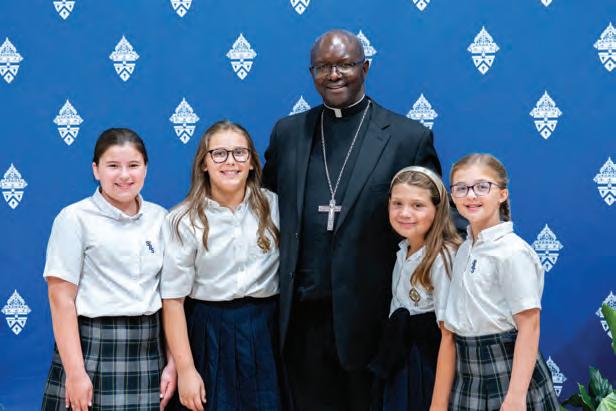
Our prayers are with you!

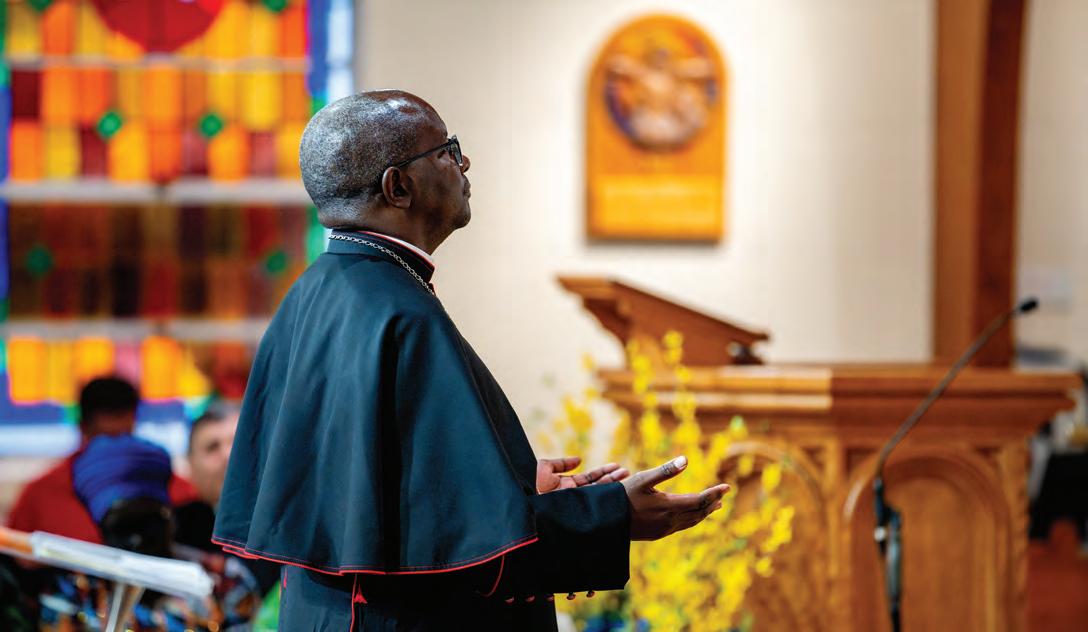
A CHARISMATIC PRAYER SERVICE UNITING CONTINENTS:
ST. BERNADETTE CHURCH, HOUMA, LA
BY: BEVI FONTENOT AND JOE O’SULLIVAN
When Bishop Simon Peter was still working for the Ugandan government, he attended a Charismatic Prayer Service. Perhaps unbeknownst to him, it would change the trajectory of his life. It was there that he met Bishop Sam Jacobs, who became a mentor to him. Bishop Jacobs eventually invited him to the Diocese of Houma-Thibodaux to study for the priesthood, and Bishop Simon Peter remained involved in the Charismatic Renewal, and Charismatic-style prayer services, ever since.
It was fittig, then, for Bishop Simon Peter to begin the week of festivities leading up to his Ordination as Bishop with a Charismatic prayer service. The night was attended by dozens of friends and family from Uganda, as well as many in the wider community of Houma-Thibodaux, both in person and watching via the livestream.
The evening was led and moderated by longtime friends of Bishop, Deacon Larry Oney and his wife
Andi of Hope and Purpose Ministries in Kenner, LA. Deacon Larry opened the night with a prayer, declaring the Lord as Eucharistically present. He invoked the power of St. Michael the Archangel to defend the congregants as they prayed, in particular that he would defend their thoughts and their minds. He also invoked the power of Mary to sit with the crowd as they prayed throughout the night. It was a powerful way to begin.
At one point, Deacon Larry invited congregants to share any “prophetic words” they received during prayer. One gentleman shared a vision of an angel standing with one foot in Louisiana and one foot in Africa. The waters were unsettled and suddenly rough underneath the angel. But through his power, the waters started calming down. The image was meant to signify Bishop Simon Peter’s leadership, bridging the continents while providing calm and stability as the new Bishop.
Deacon Larry then led the congregation through three prophetic gestures intended for Bishop’s encouragement and spiritual edification.


First, the congregation prayed that the fie of the Holy Spirit would come down upon Bishop. As Deacon instructed during the service, “We’re praying for fresh fie.” The scene echoed what Fr. Andre Melancon had emphasized before the service: “The Charismatic Renewal begins through Pentecost… [when] the Holy Spirit animated the Church with gifts of the spirit and fruits of the spirit.”
Bishop Sam Jacobs sat by Bishop Simon Peter during the entire service, often raising his hands and praying over him. He proclaimed an exhortation from St. Gregory the Great, as it was his feast day. “Remember that before you become a pastor, you were a sheep in the flock of the Lord. In the eyes of God, you will always be a sheep whom He pastures. Stay close to the Lord and learn from Him how to pasture His sheep.”
Secondly, the congregation commended the care of Bishop Simon Peter fully to Mary. Bishop’s mother, who was present from Uganda, came to stand with Bishop for this beautiful dedication of her son to the Blessed Mother.

And if the previous gesture wasn’t already causing tears in the crowd, the third surely did. The many priests in attendance surrounded Bishop in solemn prayer, placing a hand on his shoulders or extending a hand to pray for him. It was a powerful and emotional moment of brotherly love and affirtion for the man who’d been chosen to lead them–and us–in this new chapter in our diocese.
As the event wound down, Deacon Larry offered us all an important reminder. Sometimes we think that we need to be priests to share Jesus with others, but as Christians we can be like the perfume of Mary of Bethany’s ointment that filled the whole house when she anointed the Lord’s feet (Jn 12:3). “Wherever you are,” Deacon exhorted, “break the alabaster jar.”
To close, the priests were invited forward once more to lead the congregation in singing the “Great Amen” together. As Andi Oney described it, “Tonight was an experience of us being in the upper room,” like the Apostles at Pentecost.
Special thanks to the community of St. Bernadette Church for their hospitality and beautiful Cajunthemed reception.


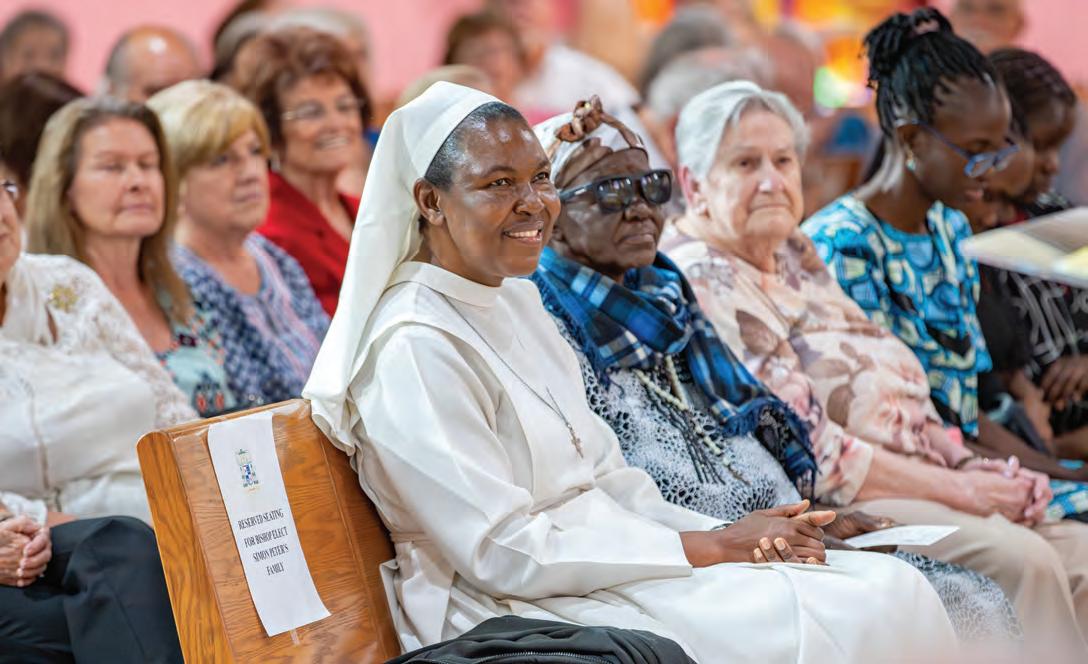






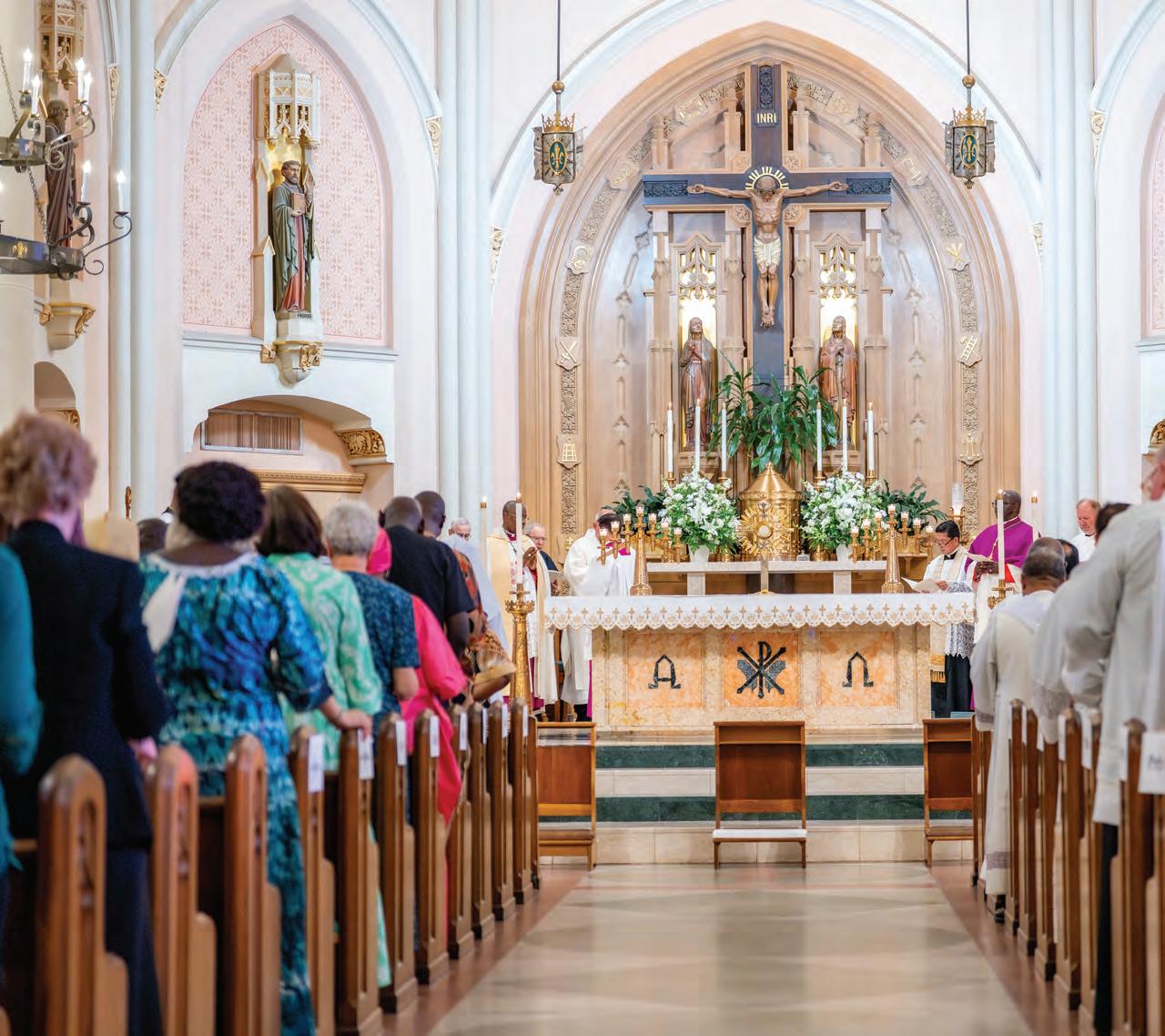
THE NIGHT BEFORE THE DAWN
SOLEMN VESPERS USHERS IN A NEW CHAPTER FOR THE DIOCESE OF HOUMA-THIBODAUX
BY: BEVI FONTENOT AND JOE O’SULLIVAN

St. Francis de Sales Cathedral in Houma was packed—with bishops, priests, religious, lay-faithful, and family and friends who had traveled from Uganda and across the United States.
Vespers, Latin for “evening,” is the Church’s traditional name for Evening Prayer. It’s part of the Liturgy of the Hours prayed daily by clergy and religious. On this occasion, the prayers were drawn from the Thursday of the Twenty-Second Week in Ordinary Time. Per our bishop’s request, Solemn Vespers was celebrated in the presence of the Blessed Sacrament. Apart from the formalities, the entire evening was elevated not just in title, but also in spirit and reverence.
Dozens of diocesan and visiting priests processed into the Cathedral. Special guest Bishop Jerome Feudjio of the U.S. Virgin Islands led the celebration. A close friend of Bishop Simon Peter, he is the fist African-born bishop in the United States (making Bishop Simon Peter the second, and the fist in the mainland United States!).
Before a priest can be ordained bishop, he must make a profession of faith and take an oath of fidelity to the Apostolic See. We witnessed our Bishop recite the Nicene Creed, affirmg his belief in the teachings of the Catholic Church. He then took the oath of fidelity, vowing to 1) faithfully carry out the duties of his office, 2 ) hold fast to the entire deposit of faith and avoid contradictory teachings and 3 ) to follow common discipline and all ecclesiastical laws in communion with the College of Bishops as authentic teachers and governors of the Church.
Bishop Jerome blessed the episcopal insignia of Bishop-Elect Simon Peter, which is comprised of his ring, miter, and crozier. The ring symbolizes his fidelity to the Church, the miter signifies his resolve to pursue holiness, and the pastoral staff (crozier) signifies the duty of guiding and governing the Church entrusted to him. Now he was officially ready and prepared to become our leader and shepherd.
At that time, Solemn Vespers began in earnest, starting with the exposition of the Blessed Sacrament, which set the tone for the solemn prayers. The pontifical choir sung “O Salutaris Hostia” in Latin, permeating the cathedral with sounds of heaven.
Both clergy and congregants prayed Vespers together, which included chanted prayers, psalms, antiphons and readings. It also featured a fervorino–a brief, inspiring exhortation–by Fr. Joseph Palermo, one of the many mentors of Bishop Simon Peter, and the current pastor at St. Francis Xavier Catholic Church in Metairie. “Pray for and support your new bishop, now and all the days of his episcopacy,” he told the congregation.
The cathedral was alive with reverent expectation as the faithful prayed not only with our BishopElect, but also for him as he prepared to take up his new role. After a year and a half without a bishop, the moment brought a profound sense of relief, comfort and hope to the diocese. Yet it was more than relief: it was also an embrace of Bishop-Elect Simon Peter himself—his character, his ministry, and the shepherd he had already been to us.
After the concluding prayer, moments of silent prayer were observed in the presence of the Most Blessed Sacrament. Benediction and divine praises followed these quiet moments, and then the Blessed Sacrament was reposed.
After the recessional hymn, the congregation made their way to Vandebilt Catholic High School, where fellowship and celebrations continued at a reception held in the Brother Alfred Kolb Gym. Groups gathered excitedly for pictures with our Bishop-Elect, and a beautiful slideshow of photos from Bishop Simon Peter’s journey played on the screen. Children from St. Francis Catholic Elementary School served lemonade with smiles on behalf of the children’s chapter of the Women’s Giving Circle.
As the evening drew to a close, hearts were united in anticipation. With less than twenty-four hours remaining, the Diocese of Houma-Thibodaux was ready to receive its new shepherd, Bishop Simon Peter Engurait.

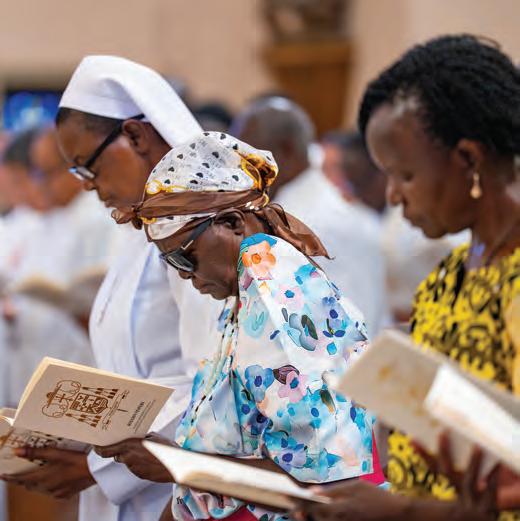
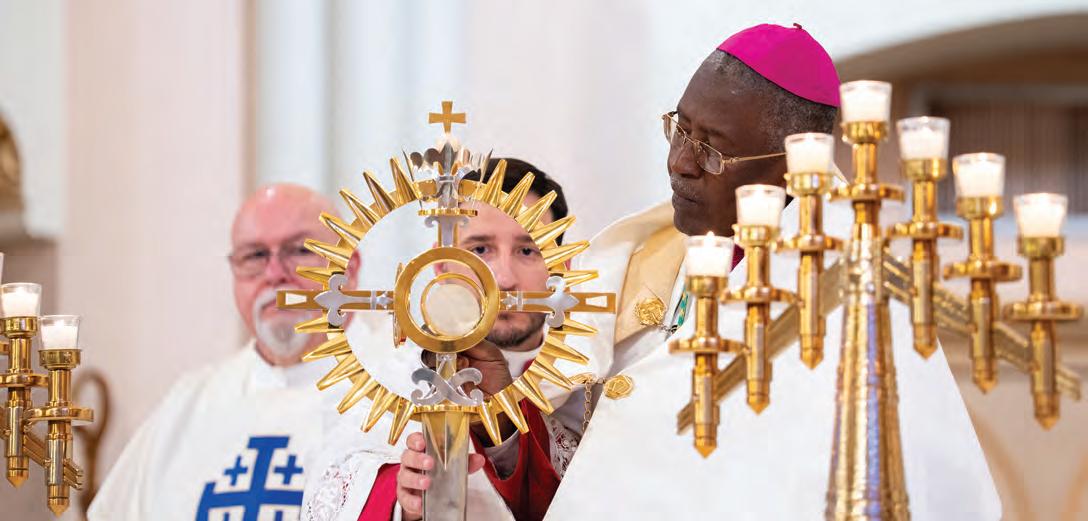
O SALUTARIS HOSTIA
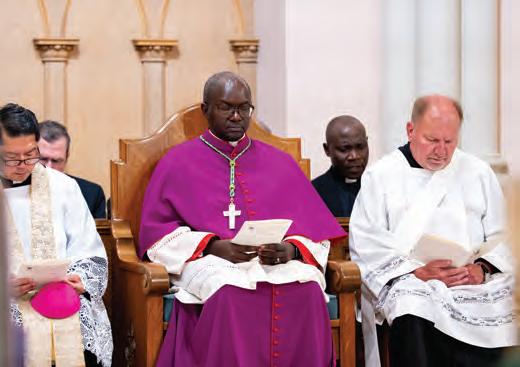
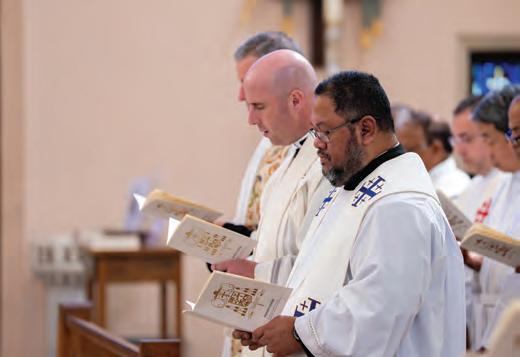



THE ORDINATION AND INSTALLATION OF BISHOP SIMON PETER ENGURAIT
THE DIOCESE OF HOUMA-THIBODAUX OFFICIALLY WELCOMES ITS SIXTH
BISHOP

BY: BEVI FONTENOT AND JOE O’SULLIVAN
The time had fially come. The ordination and installation of the Most Reverend Simon Peter Engurait as the sixth bishop of the Diocese of Houma-Thibodaux arrived on Friday, September 5, 2025.
The grand event took place in the David R. Stopher Gymnasium at Nicholls State University in Thibodaux, which provided ample space for the more than 2,100 who gathered from HoumaThibodaux and beyond.
The staff and volunteers of the Diocese of HoumaThibodaux, together with the team at Nicholls State University, had transformed the gymnasium into a cathedral worthy of a bishop’s ordination! The scene was set: an elevated sanctuary was created and installed on the stage featuring the cathedra (the bishop’s chair) from St. Joseph Co-Cathedral, topped with a crucifixand framed by drapes. Sacred items were collected from both St. Joseph Co-Cathedral and St. Thomas Aquinas, including statues of Mary and Joseph, to create a reverent sanctuary fittig for the celebration. Flowers and greenery gave it the finihing touch.
The newfound “church” filled early and quickly with guests as the start time approached.
From the entrance side, guests had a striking view of the unfolding scene: rows of Knights of Columbus in uniform, along with countless priests and bishops, who were ready to process in full vestments with Bishop-Elect Simon Peter Engurait. The room was filled with energy and expectation. In just a few moments, the Ordination Mass would begin, and our bayou diocese would at last receive its new bishop.
The procession began with the fist note of “All Creatures of Our God and King,” led by the Pontifical Choir. The majestic hymn reflected the enormous crowd that packed the floor seating area, up into the stands on both sides of the arena. All congregants stood to welcome the sea of priests and bishops processing in joyfully. The bishops were greeted by a change in hymn, “Ecce Sacerdos Magnus” (Latin for “Behold, a great priest”):
“This is a priest most mighty, who in his days among us found the Lord’s favor. Swearing an oath to uphold him, God therefore in glory exalted him among his people. And the Lord’s own blessing of all nations upon the earth was upon him, and he has confirmed his holy covenant upon his head in honor.”


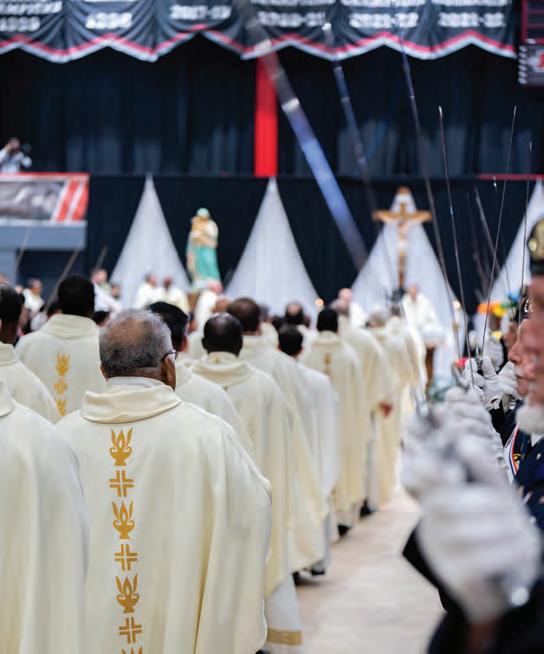
Once the 250 priests and bishops made it to their seats, the sign of the cross was made by all, and the Mass officially began.
The Mass and Rite of Ordination was celebrated by His Excellency, the Most Reverend Gregory M. Aymond, Archbishop of New Orleans. He was joined by coconsecrators, the Most Reverend Shelton J. Fabre (fourth bishop of the Diocese of Houma-Thibodaux), now Archbishop of Louisville, and the Most Reverend Sam G. Jacobs, Bishop Emeritus and third bishop of HoumaThibodaux. The ordination was also celebrated in the presence of His Eminence Christophe Cardinal Pierre, Apostolic Nuncio to the United States.
The Liturgy followed the ordinary order of the Mass, continuing with the Penitential Act and the “Gloria” being led by the Pontifical Choir.
The fist reading was from the Book of the Prophet Jeremiah proclaiming, “Before I formed you in the womb, I knew you” (1:4-9). For the responsorial psalm, Bishop Simon Peter chose Psalm 146, “Praise the Lord, my soul.”
The second reading was taking from the Letter to the Hebrews (5:1-10 ), “You are a priest forever according to the order of Melchizedek.”



There was no gospel more fittig to read than this one from the Gospel of John (21:15-17):
When they had finished breakfast, Jesus said to Simon Peter, “Simon, son of John, do you love me more than these?” He said to him, “Yes, Lord, you know that I love you.” He said to him, “Feed my lambs.”
He then said to him a second time, “Simon, son of John, do you love me?” He said to him, “Yes, Lord, you know that I love you.” He said to him, “Tend my sheep.”
He said to him the third time, “Simon, son of John, do you love me?” Peter was distressed that he had said to him a third time, “Do you love me?” and he said to him, “Lord, you know everything; you know that I love you.” Jesus said to him, “Feed my sheep.”
Following the readings, the Rite of Ordination began with the hymn, “Veni, Creator Spiritus” (“Come, Holy Spirit”), which invoked the very power by which Archbishop Aymond would soon ordain Bishop-Elect Simon Peter: the Holy Spirit.
Bishop-Elect Simon Peter was then called to the Sacred Order by Very Reverend Father André Melancon on behalf of our diocesan priests. The Apostolic Letter from


the Apostolic Nuncio was read aloud and presented to him. Holding up the parchment inscribed with formal script, he showed it to the College of Consultors for approval as is the custom. He then processed through the aisles, holding up the letter with a smile as the crowd erupted in cheers and applause! Triumphant ululations, or jubilant cries, could be heard from the Ugandan women in attendance, especially his mother. As he walked section by section, the cheers continued in waves of joy. Many reached out to touch his shoulder as he passed by, unable to contain their excitement. Many were moved to tears as they witnessed this historic moment—not only for our diocese, but also for him, his family, for Uganda, and for the entire world—as we celebrated the fist African-born man to be ordained a bishop in the mainland United States. The lay-faithful certainly gave their consent with unanimous and unwavering affirtion.
Everyone was seated, and Archbishop Aymond began his homily. “I think it’s safe to say that everybody here is excited,” he smiled. He then quoted Bishop-Elect Simon Peter, who had read the following meditation on the morning of Tuesday, May 27 during his regular morning prayer time, “There is nothing more important than to say yes to Jesus with all of your heart.” As Archbishop
Aymond pointed out, Cardinal Christophe Pierre would call Father Simon Peter later that day to inform him that Our Holy Father, Pope Leo XIV, had appointed him as the next bishop of the Diocese of Houma-Thibodaux.
Archbishop Aymond continued, “Today, Simon Peter, we thank you for saying yes to the Lord and to His Church. You have served well in priestly ministry and as vicar general, and all of us have gathered here today to pray with you and to pray for you.”
He ended his homily with a quote from the Holy Father Pope Leo XIV, “When families feel overwhelmed, when young people are disillusioned, or when the marginalized feel abandoned, the bishop is close to them—not offering easy solutions but helping them live the gospel in simplicity and in solidarity.”
Archbishop Aymond proceeded to formally question Bishop-Elect Simon Peter on his willingness to embrace the Office of Bishop, to which he responded resoundingly to each question with “I do.” Bishop-Elect lay prostrate on the floor, a gesture of prayer and humble surrender to the Lord, as the Litany of Supplication was sung.
Archbishop Aymond, joined by his co-consecrators, Archbishop Fabre and Bishop Jacobs, laid their hands on his head in silence. All 40 bishops in attendance then had the opportunity to do the same, signifying apostolic succession.
It was then time for the official prayer of ordination. Bishop-Elect knelt as deacons held open the Book of the Gospels over his head, as Archbishop Aymond recited the prayer of consecration. The bishop-elect was then anointed with the Oil of Sacred Chrism, poured over his head. Archbishop prayed that, through this holy anointing, he may be enriched with spiritual blessings.
Archbishop Aymond then presented Bishop Simon Peter with the episcopal insignia, the signs of his office as bishop, which were blessed the evening before by Bishop Jerome Feudjio. These include three elements: a ring, symbolizing the Bishop’s fidelity to the Bride of Christ, the Church; the miter signifying his resolve to pursue holiness; and the pastoral staff (crozier) signifying the duty of guiding and governing the Church entrusted to him. He put on his ring and miter, and held the crozier firm in his and.
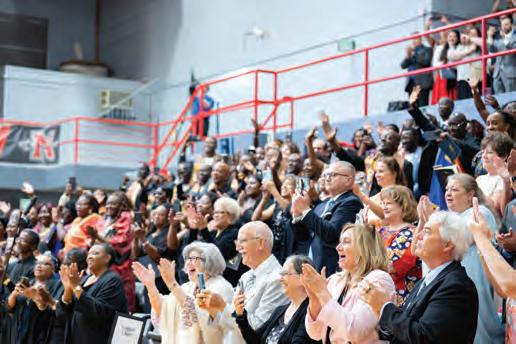


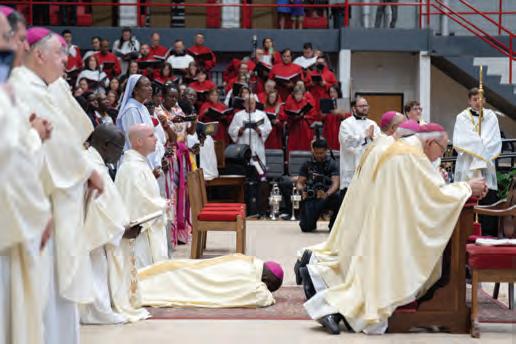


At last, Archbishop Aymond, along with Cardinal Pierre, walked Bishop Simon Peter to his cathedra for him to officially take his seat as the sixth bishop of the Diocese of Houma-Thibodaux! The cathedral erupted in applause as a new chapter in our diocese’s history began.
With this, the celebration moved into the Liturgy of the Eucharist. For the offertory, a special Ugandan procession brought the gifts forward with a simple dance, which is customary in Ugandan culture. The song “Utukuzwe” was sung in Swahili by the Ugandan choir. The choir was also dressed in traditional Ugandan attire, with women in Gomesis or Mushanana and men in white Kanzu and black coats to show the dignity of the event.
Ugandan ululations could be heard throughout the ceremony. These high, jubilant cries made by women in African cultures celebrate sacred and joyful occasions. We were exposed to these at every event this week!
Did you know there were four choirs and five languages in this service? We heard songs from the Pontifical Choir, the Ugandan choir, the Diocesan Spanish Choir, and the Diocesan Gospel Choir. We also heard five languages: English, Spanish, Latin, Swahili and Luganda, a major Bantu language of Uganda. We also welcomed talented organist, Thibault Fajoles, formerly the youngest organist ever at Notre Dame Cathedral in Paris!
Following the celebration of the Eucharist, Bishop Simon Peter processed through the aisles once more to bless the attendees, as well as the many clergy and religious present. He then returned to the pulpit to address the entire congregation, expressing his gratitude to the many attendees who traveled locally and from around the world. He thanked all of his past mentors, from his previous career to his priesthood.
“Who would have imagined that I would one day stand before you as a bishop of the church? I stand here not because of my worthiness but because of God’s mercy,” he said.
“This day is not mine alone,” but “a fruit of so many who have walked with me. Now more than ever, I need to walk even more closely with you as bishop,” he continued. “Jesus Christ is present. That means together we make Christ present…we are a family on a mission.”
Bishop Simon Peter honored his mother, Crencentia, sharing how she has “embodied God’s strength and tenderness,” and thanked his native Uganda, noting that he “will always be proud to be a son of that soil born from a land and a church watered by the blood of the martyrs.”
“As a new bishop, I promise you that my fist labor will be to stay close to Jesus so that everything I do flows from His love,” he said. “A bishop is not meant to be a distant administrator, but rather a pastor who walks among his people. I want my ministry to be a ministry of presence. I want to be close to your families and parishes, close to you in your joys and in your sorrows, feeling with you the burdens you carry. I want to be a gentle and humble shepherd, never forgetting that the church is for service to those most in need.”
“From the source of the Nile River to the Bayou country, I am home.”
Officially ordained, all the priests and bishops began their procession out of the Church, with hymns led by the Pontifical Choir. This time, Bishop Simon Peter followed behind them, but with ring, miter, and crozier in hand. They were met by Ugandan dancing, songs, and triumphant ululations outside.
A lovely reception was held in the Nicholls Cotillion Ballroom afterwards. Guests filled the space, enjoying delicious food and fellowship. Children from St. Joseph Catholic Elementary School served lemonade for the children’s chapter of the Women’s Giving Circle. A line extended all the way down the ballroom for attendees to take a picture with Bishop Simon Peter, who was beaming with pride and joy—starting a new chapter not only in his life, but in ours too.
CONGRATULATIONS TO BISHOP SIMON PETER, THE SIXTH BISHOP OF HOUMA-THIBODAUX!





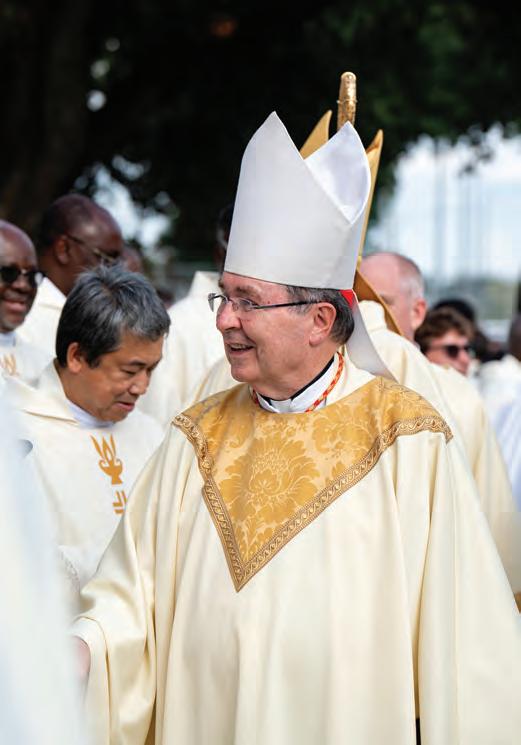

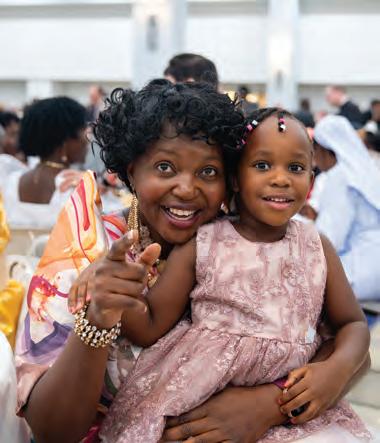



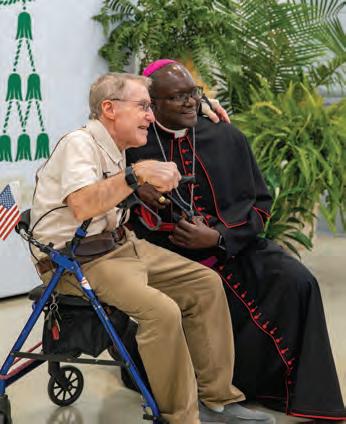

I WANT MY MINISTRY TO BE A MINISTRY OF PRESENCE. I WANT TO BE CLOSE TO YOUR FAMILIES AND PARISHES, CLOSE TO YOU IN YOUR JOYS AND IN YOUR SORROWS, FEELING WITH YOU THE BURDENS YOU CARRY.
I WANT TO BE A GENTLE AND HUMBLE SHEPHERD, NEVER FORGETTING THAT THE CHURCH IS FOR SERVICE TO THOSE MOST IN NEED. A PRESENCE. WANT TO AND HUMBLE CHURCH IS THOSE MOST

A WEEKEND OF CELEBRATION AND GRATITUDE
BY: BEVI FONTENOT


BISHOP’S FIRST MASS OF THANKSGIVING AND A SPECIAL GIFT FOR MOM
On Saturday, September 6 at 4 p.m., St. Joseph CoCathedral hosted the fist Mass of Thanksgiving for Bishop Simon Peter. This was the fist Mass celebrated by our new Bishop, and he took his place in the cathedra (bishop’s chair), adorned with his coat of arms. This was the same chair he sat in for the fist time at the ordination and installation!
This Mass featured a Ugandan choir from all around the United States, bringing vibrant rhythms, lively beats and heartfelt praise! Drums and traditional Ugandan instruments were used by this music ministry to create unique sounds and melodies. The women in the choir wore white dresses with black embroidery, while men in the choir wore formal black suits.
The Church was at capacity, seating nearly 700 people. During the entrance hymn, the congregation clapped to the beat, and the crowd erupted in joy upon the entrance of Bishop Simon Peter. You could also hear traditional Ugandan ululations—a high, jubilant cry made by women in African cultures to celebrate sacred and joyful occasions.
In his homily, Bishop Simon Peter reflected on apostolic succession and his role as a shepherd. “I am only an instrument. God is the ultimate shepherd,” he said. “It will not be easy, but He will be with me.” He continued, “The greatest tragedy is not to be a saint, and not to get to
heaven. As a successor of the apostles, it is my mission to get you to heaven. Now more than ever, I rely on your prayers.”
The Profession of Faith was sung by the choir. In the prayers of the faithful, Bishop Simon Peter prayed for the repose of the soul of his father Clement and his brother Joseph.
The offertory hymn featured a graceful and simple Ugandan dance as the gifts of bread and wine were brought up to be received by Bishop Simon Peter.
Our Bishop raised his hands during the Liturgy of the Eucharist as he sang, “We sing with the angels; Hosanna in the highest!”
At the conclusion of the Mass, Bishop had a special surprise for his mother.
During his ordination, one of the most powerful moments was the anointing of his head with sacred chrism. This anointing symbolized the outpouring of the Holy Spirit, consecrating him to sanctify, teach, and govern in Christ’s name. The fragrance of the chrism represented the sweetness of Christ’s presence and the call to holiness.
“By cherished custom, this linen is presented to the bishop’s mother—a gesture of honor and gratitude, recognizing her role in giving life, nurturing faith, and guiding her son toward his vocation.”
“The cloth becomes for her a treasured sign of both her maternal sacrifice and her share in the mystery of her son’s priestly and episcopal consecration,” he continued. “Tradition holds that, at her death, it may be placed in her hands as a symbol of her offering to God as a mother who has given her son to the service of Christ and His Church. Today, I joyfully offer this gift to my mother, who fist gave me the gift of life.”
His mother and family stood with joy as Very Rev. Vic DeLa Cruz, Pastor of St. Joseph Co-Cathedral, presented her with the linen cloth. This was followed by a long, loving embrace between Bishop and his mother. Many were teary-eyed witnessing this beautiful moment of family and faith.
A reception was held at The Oaks Venue, where the community gathered to celebrate. Bishop Simon Peter greeted guests, offering his thanks and gratitude.


I AM ONLY AN INSTRUMENT.
GOD IS THE ULTIMATE SHEPHERD

A JOYFUL MASS OF THANKSGIVING AT OUR CATHEDRAL CHURCH
The fial celebration of the week was a special Mass of Thanksgiving on Sunday at 11 a.m. at the Cathedral of St. Francis de Sales in Houma. This was Bishop Simon Peter’s fist Mass in the Cathedral of the diocese, and his fist time sitting in the primary cathedra (the bishop’s chair).
The Ugandan choir once again blessed us with their music ministry, highlighting Ugandan cultural practices and jubilant song. The choir was dressed in traditional attire called Kitenge, a little less formal than what they wore during the Ordination Mass on Friday.
Bishop Simon Peter blessed the children going to children’s liturgy, reminding them how much God loves them. During the Gospel Acclamation, the Book of Gospels was processed up in basket, signifying that the Word of God is the food that will nourish us.
In the homily, Bishop Simon Peter shared remarks of joy, gratitude and thanksgiving. “I have the privilege
to be the sixth to sit in the cathedra chair in this cathedral,” he reflected. “This is the home of my ministry and one day, my fial resting place will be with that ministry.”
After the intercessory prayers, in which Bishop Simon Peter petitioned for the repose of the soul of his father Clement and brother Joseph, family and friends participated in a special offertory procession: a simple dance with the presentation of baskets of food and goods, along with the bread and wine for consecration.
At the end of the liturgy, Bishop Simon Peter thanked everyone for coming out in large numbers throughout the week.
A reception was held in the KC Hall where Bishop Simon Peter and his family mingled with parishioners.









THANK YOU
The Diocese of Houma-Thibodaux extends its heartfelt thanks to everyone who made the ordination and installation week of Bishop Simon Peter so memorable. From volunteers and parish staff to donors and participants, your dedication, generosity, and prayers brought these celebrations to life. Because of you, we witnessed a truly inspiring week of faith, fellowship, and joy.
Thank you for being part of this historic moment in our Diocese!

MESSAGES FOR BISHOP SIMON PETER


A MESSAGE FROM BISHOP JACOBS
+Simon Peter,
It was with great joy and thanksgiving to God that I heard that Pope Leo appointed you Bishop of the Diocese of Houma-Thibodaux. It is the joy of a spiritual father that has walked with you on your vocational discernment and your decision to enter the Seminary for our Diocese. It was with great joy that I was privileged to ordain you as a priest of Christ. It will be greater joy to be one of the co-consecrations at your episcopal ordination. I pray that God will endow you with the additional gifts of the Holy Spirit to be the Shepherd of his people. Ad Multos Annos!
Bishop Sam Jacobs
A MESSAGE FROM BISHOP JARRELL
Dear Bishop Engurait:
I’m extremely pleased to extend heartfelt congratulations on this blessed occasion! Thus far I have approved of all of Pope Leo’s actions and your appointment is no exception. You know the people of the Diocese of Houma-Thibodaux very well. They have welcomed you as a priest; now they welcome you as their bishop. I know that you will serve them well. I pray for God’s blessings upon you and them for many years to come.
Bishop Michael Jarrell



A MESSAGE FROM ARCHBISHOP FABRE
With praise and thanksgiving, I celebrate with the Diocese of Houma-Thibodaux on the appointment of my dear friend Bishop Simon Peter Engurait as the Sixth Bishop. As he begins his new episcopal ministry, he will be guided by the Holy Spirit as he leads with the heart of Jesus Christ. I have known Bishop Simon Peter for over 9 years having served as my vicar general and moderator of the curia during my episcopacy in Houma-Thibodaux. He is a man of great faith, a pastor, and a humble servant who will shepherd the people of the diocese well. I pray for God’s blessing on Bishop Simon Peter, his episcopal ministry, and the faithful of the Diocese of Houma-Thibodaux. Congratulations!
Most Rev. Shelton J. Fabre Archdiocese of Louisville, KY

August 8, 2025
A MESSAGE FROM THE NUNCIO
Prot. N. 24553 / 25
Dear Father Simon Peter,
Dear Father Simon Peter,
Congratulations on your appointment as Bishop of Houma-Thibodaux! Having known you many years ago during our time in Uganda, I fid it a special joy to celebrate now your episcopal consecration. I am pleased for the people of your Diocese who will have you as their shepherd.
Congratulations on your appointment as Bishop of Houma Thibodaux! Having known you many years ago during our time in Uganda, I find it a special joy to celebrate now your episcopal consecration. I am pleased for the people of your Diocese who will have you as their shepherd.
Assuring you of my prayers and best wishes for a happy and fruitful ministry, I remain
Assuring you of my prayers and best wishes for a happy and fruitful ministry, I remain
Sincerely yours in Christ,

Cardinal Christophe Pierre Apostolic Nuncio

The Most Reverend Simon Peter Engurait
Bishop-Elect of Houma-Thibodaux
Pastoral Center
P.O. Box 505 Schriever, LA
IN DEO TANTUM
THE SIGNIFICANCE OF THE COAT OF ARMS
BY: BEVI FONTENOT
Every episcopal coat of arms has two elements: symbols that are common to every bishop, and symbols that are unique to each bishop.
Common to all bishops is the traditional shield that represents faith; it is surmounted by a traditional green hat called a galero. This represents a pilgrim’s hat and serves as a reminder that we are all pilgrims on a journey to Heaven. From the hat flows six green tassels on each side, representing the rank of a Bishop. Between the shield and the galero is a gold processional cross, to show that Christ and his Cross are the center of a bishop’s life.
A bishop’s coat of arms is traditionally combined with the arms of his diocese on the left side of the shield. Since we are a “dual city diocese,” this section is divided into two main parts: the top for Houma and the bottom for Thibodaux. The upper half is itself divided: the blue portion displays three gold fleurs-de-lis, representing our French and French-Canadian heritage, while the red portion bears a silver cross with a gold flaming heart, honoring Saint Francis de Sales, patron of the Cathedral in Houma. The lower half is light blue, bearing a silver carpenter’s square arranged as a chevron (upside down “V”) between three silver lilies, symbolizing Saint Joseph, patron of the Co-Cathedral in Thibodaux.
On the right side of the episcopal coat of arms, Bishop Simon Peter Engurait has selected symbols that represent his personal heritage, spiritual journey, and vocational mission.
The topmost section is white with an open-winged red dove, representing the Holy Spirit—the Lord and Giver of Life—whose presence and power he has experienced profoundly through the Catholic Charismatic Renewal. The Holy Spirit continues to guide him, breathe life into his ministry, and set his heart on fie for Christ.
Under the dove is a blue section with three white stars to honor Our Blessed Mother. Traditionally, the three stars symbolize Mary’s virginity before, during, and after the birth of Jesus. From childhood, Bishop Simon



DESIGNED BY
CONNOR MABILE
Peter was introduced to the Blessed Mother and has continually felt her maternal care throughout his life. His devotion to her continues to grow as she walks with him as a mother and model of discipleship.
In a white section underneath the stars is the red Sacred Heart of Jesus, aflame and encircled with a crown of thorns. The Sacred Heart represents God’s love that surpasses all understanding—a love that suffers, heals, and saves. It is the very heart that Bishop Simon Peter seeks to imitate as a bishop: a heart united to the Lamb of God, poured out in mercy.
On the bottom blue portion is a white deer drinking from flowing waters. The duiker deer is the totem of Bishop Simon Peter’s ancestral clan in Uganda, while deer also represent our culture in South Louisiana. Above all, it calls to mind Psalm 42 : “As the deer longs for streams of water, so my soul longs for you, O God.”
The white streams of water beneath the deer carry many meanings, and the fist is that water is life. But for Bishop Simon Peter, water also represents a few other important things. It symbolizes the River Nile that flows north from his native home in Uganda, as well as the bayous of our beautiful diocese, his new home. It also symbolizes the waters of baptism and the living water of the Spirit that unites and sustains us. From the Nile to the bayou, God has been faithful.
The colors of his episcopal coat of arms—blue, white, and red—also carry special significance. Blue is long associated with Our Lady. It is also the color of our Louisiana state flag, a symbol of lifegiving water, and, fittigly, the Bishop’s favorite color. Red signifies fie, love, and sacrifice, while white symbolizes purity and joy.
On the bottom ribbon is his episcopal motto: “In Deo Tantum” or “In God Alone.” Without God, we are nothing; with God, we have everything. It is beautifully expressed in Psalm 62 , a prayer he carries close to his heart: “My soul rests in God alone…He is my rock, my salvation, my fortress.” May we all rest our hearts in God alone.
COAT OF ARMS DEPICTED BY STUDENTS FROM OUR CATHOLIC
SCHOOLS:




THE SYMBOLS OF A BISHOP SACRED SIGNS:
BY: BEVI FONTENOT
When a priest is ordained as a bishop, the Church entrusts him with sacred symbols that point to his mission, identity, and responsibilities as a successor of the apostles. These signs, known as the episcopal insignia, are not mere ornaments but visible reminders of the spiritual duties of his new office.
At his ordination, Bishop Simon Peter Engurait received three central insignia: the ring, the miter, and the crozier. Each carries profound meaning and calls the bishop to live out his ministry in the likeness of Christ, the Good Shepherd.
THE EPISCOPAL RING
The ring is placed on the bishop’s figer as a sign of his spiritual marriage to the Church. Just as a bridegroom is united to his bride, the bishop is bound in faithful love to the people of God entrusted to his care. It represents permanence, fidelity, and unity—reminding the bishop daily of his lifelong commitment to serve Christ and His Church.
THE MITER
The tall, pointed headdress known as the miter is worn when the bishop presides at liturgical celebrations. It symbolizes his call to holiness and his responsibility to teach the truths of the faith. The two points of the miter are often understood as representing the Old and New Testaments, with the bishop tasked with proclaiming the Word of God faithfully.
THE CROZIER
The crozier, a staff shaped like a shepherd’s crook, is perhaps the most recognizable of the bishop’s symbols. It represents his role as a shepherd of souls, called to guide, protect, and care for his flock in imitation of Christ, the Good Shepherd. The crozier reminds both the bishop and the faithful of his duty to lead with love, gentleness, and truth.
MORE THAN SYMBOLS
Together, these insignia embody the bishop’s mission: to sanctify, teach, and govern the people of God. They remind him—and all of us—that at the heart of his authority is a heart of service, rooted in Christ’s love.
As Bishop Simon Peter begins his ministry in the Diocese of Houma-Thibodaux, these sacred signs point to the heart of his vocation: to walk with his people, teach with wisdom, and shepherd with compassion, always pointing to Christ.


SYMBOLS OF BISHOPS DEPICTED BY STUDENTS FROM OUR CATHOLIC SCHOOLS:
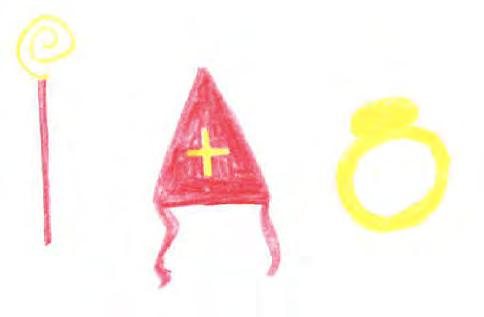
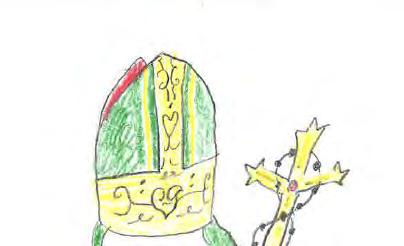

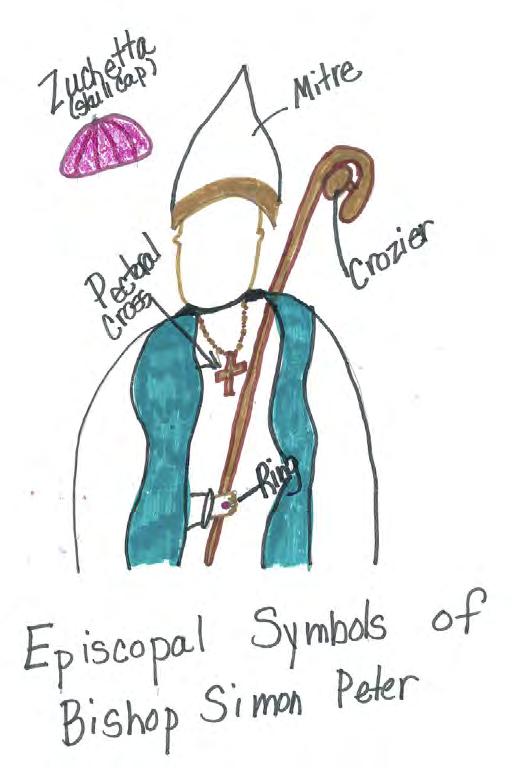

EYES OF A NEPHEW:
MY UNCLE, THE BISHOP THROUGH THE



TELL
In this special feature, Bishop Simon Peter’s nephew George Edward Olokojo shares his unique experiences with his uncle and the impact he has had on his life.
George is currently studying pre-theology at St. Meinrad School of Theology in Indiana. He is a seminarian in the Archdiocese of Louisville.
US HOW IT WAS GROWING UP WITH BISHOP SIMON PETER AS AN UNCLE. WHAT ARE SOME OF YOUR BEST MEMORIES OF HIM FROM CHILDHOOD?
I am one of five siblings, and I am the second. Bishop Simon Peter is a brother to my late dad. Getting to know Simon Peter as an uncle was wonderful. He often visited us during school breaks, especially at Christmas.
My siblings and I took turns spending holiday days with him. He would give us ice cream when he was pleased, for example when we did well at house chores. He had so many friends who would often visit and shower us with love. Everyone loved being in his car as he always played some nice gospel music. A song I vividly remember him playing is “Righteousness, Peace and Joy” by Ron Kenoly, among other amazing hits.
The most important memory for me is the evening he took me to a charismatic prayer meeting at Christ the King Church in Kampala. It was my fist time at such a powerful worship meeting. From that night, I fell in love with the charismatic renewal movement and never turned back. I grew to love worship so much that I learned piano and guitar. While pursuing my bachelor’s degree at the university, I served in leadership for the charismatic renewal movement. I owe all of this to that fist encounter my uncle gave me.
WHAT ARE THE QUALITIES YOU ADMIRE THE MOST IN HIM?
Quite a number, I would say. He has a deep love for God that inspires those around him to live with purpose and faith. His heart for charity is inspiring, always seeking ways to uplift others. When it comes to leadership, he stands out—not just for his clarity and eloquence of speech, but for the way he listens with full attention, making others feel valued.
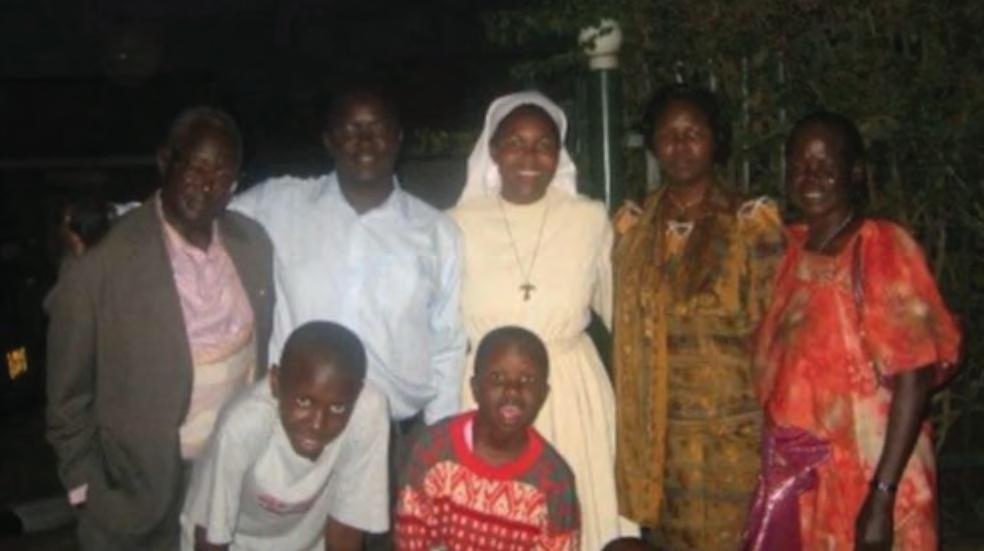
HOW HAS HE SUPPORTED YOU THROUGH YOUR VOCATIONAL DISCERNMENT?
He has played a significant role in my journey of vocational discernment. His vocation story alone kept the fie of my calling alive even during moments of doubt. He doesn’t just speak about God; he lives in a way that makes God visible. I’ve had the opportunity to be with him on pilgrimage to Holy Sites. I cannot forget the pilgrimage to Our Lady of Kibeho in Rwanda where my interest in the journey to the priesthood became clearer to me. When I shared my desire to join the seminary, he didn’t hesitate. He listened with warmth and his response was full of encouragement, not just in words but in action. Since then, he has always guided me, giving advice and the necessary support.
WAS THIS YOUR FIRST TIME TO THE HOUMA-THIBODAUX AREA? WHAT DID YOU THINK OF IT?
It was my fist time visiting, and I was deeply moved by the vibrant faith of the Houma-Thibodaux community.
I was hosted at St. Genevieve Parish, and I attended a morning Mass at 7:00 a.m. The turnout and participation were remarkable. After Mass, I had the chance to speak with some parishioners who welcomed me warmly. I was especially touched by the love and respect they expressed for my uncle; it was truly inspiring.
WHAT WAS YOUR FAVORITE PART OF THE ORDINATION MASS? WAS THERE ANY MOMENT OR QUOTE THAT STOOD OUT TO YOU?
My favorite moment was when Bishop Simon Peter received the Apostolic letter from the Nuncio. As he walked among the faithful, displaying the message, the choir chanted, “Laudate Domine Omnes Gentes, Alleluia.” It was a powerful scene of joy, as everyone welcomed him with open hearts full of clapping and cheering. To this moment I still fid myself singing the “Laudate Domine Omnes Gentes, Alleluia.” That moment lives on in my heart as a great melody of joy.
WHAT DOES IT MEAN TO NOW HAVE A BISHOP AS A PART OF YOUR FAMILY?
It truly is a profound blessing from God. To witness a family member receive the fullness of the priesthood is a rare and sacred honor, one that fills our hearts with joy. At the same time, it’s deeply humbling; who are we, that the Lord would look upon us with such grace? My prayer is that God may bless him with all the graces and strength he needs to carry out his sacred office faithfully and with wisdom.
IS THERE ANYTHING ELSE YOU’D LIKE THE DIOCESE TO KNOW?
Thank you for the love and support shown to my uncle Bishop Simon Peter. Thank you for making HoumaThibodaux a home away from home and for your unforgettable hospitality during the installation. May God bless you abundantly as we continue this journey together as pilgrims of hope.


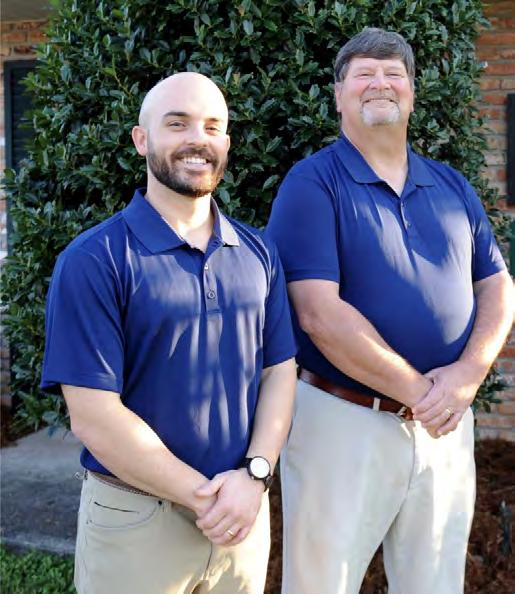

FROM SOROTI TO HOUMA-THIBODAUX

We are from a big family of 14 siblings. Out of those, three of us entered the Lord’s service: Fr. Martin Aeko, myself, and Simon Peter, whom we simply call “SP.” From early on, SP carried an unmistakable love for the Church. He became an altar server at about the age of nine, waking before sunrise on Sundays to prepare for Mass. Often times, he pedaled there on a bicycle, but other times, he walked.
He wasn’t only devoted to the altar; he also carried a special tenderness for the elderly and children. I can still see him surrounded by little ones, laughing and playing hide-and-seek. They adored him! At home, he even organized “mock Masses,” using potato slices as hosts for Communion. The priestly seed was clearly planted early.
BY: SR. SALOME MARY AGUTI
When I was in the novitiate, SP was still a little boy in elementary school. Martin, our other brother, had already joined the seminary, and Simon Peter, inspired both by him and Bishop Erasmus Wandera of the Soroti Diocese, began to feel that same tug toward priesthood. Added to that was the encouragement of our parents, Papa Clement and Toto Crencentia, who nurtured vocations with prayer and devotion. It was with little wonder, therefore, that SP would enter St. Peter’s Minor Seminary after elementary school.
Life, though, doesn’t always take a straight path! He went all the way to College Seminary (Katigondo Seminary) and then left to join university. After university, SP seemed settled in a flourishing career with Uganda’s Ministry of Finance. He wore the crisp suits of civil service and had a pensionable job many would envy.
It’s not every day that a bishop’s story is told by his sibling. But here’s a story of Most Reverend Simon Peter Engurait, sixth Bishop of HoumaThibodaux in Louisiana, written by his older sister, Franciscan Sr. Salome Mary Aguti.
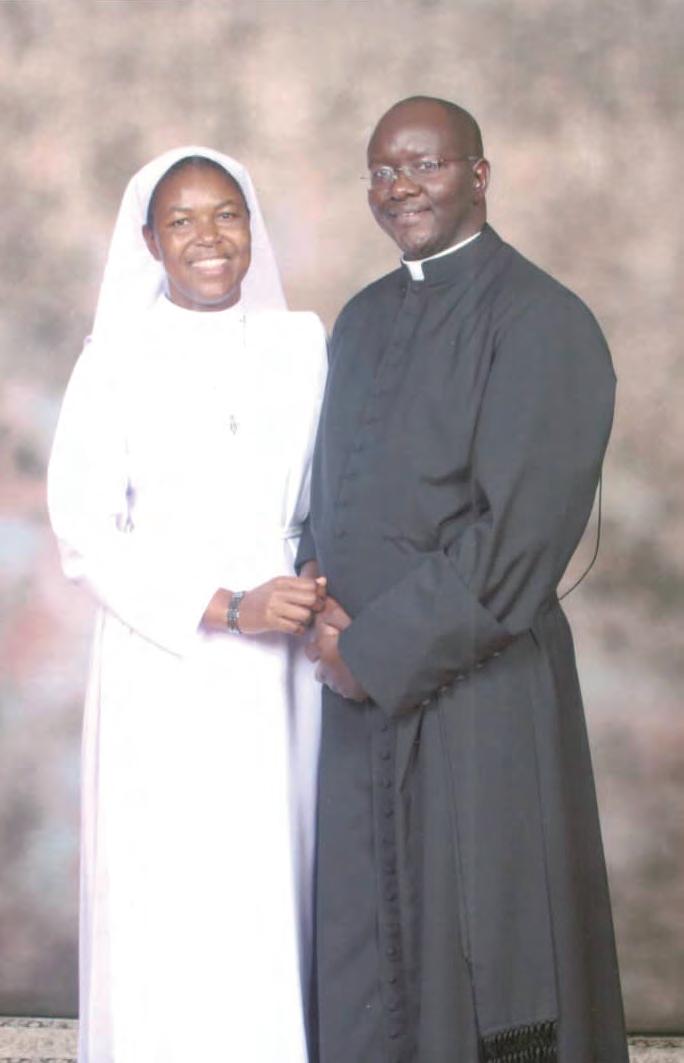

We thought perhaps the priesthood dream had faded. But had it? For there came the surprise! He announced he was leaving that secure career and heading not just to seminary, but to one overseas, in a diocese none of us knew well, much less could pronounce: Houma-Thibodaux. Family and friends scratched their heads. But to some of us in his family, the turn of events felt right.
It was painful to see him go to a foreign land we didn’t know. Nevertheless, we prayed with him, encouraged him, and even had the Charismatic Renewal group and our friend, Comboni Fr. Ruffino Ezama, gather with him and entrust SP’s decision to Jesus. When his ordination day fially came, the joy in our family was indescribable. I still remember our father’s words, echoing the prayer of Simeon: “Now, Lord, let your servant go in peace, for my eyes have seen your salvation.” And when news arrived years later that SP had been chosen as bishop, well—let’s just say the ululations could have been heard from Soroti to Louisiana!
SP the bishop is the same SP we grew up with: hardworking, humble and deeply empathetic. He has a heart for the poor and the marginalized, and a strong passion for strengthening family life. I’ve seen this especially in moments of sorrow. When we lost our sister Angela Felistus in 1997, SP stood beside her children and their father with steadfast support. More recently, when our brother Joseph was tragically murdered, SP gathered together the family for a retreat on forgiveness, to help us carry the unbearable cross with grace, entrusting all to God.
Yet here’s something you might not know about Bishop Simon Peter Engurait: behind the miter is a man who loves music and dance. At home, he was our unofficial DJ. He tinkered endlessly with sound equipment, once even placing speakers under a drum to reverberate the bass! He was also “the cameraman” of the family, never without his camera at our gatherings. This lighter side of him reminds us that a bishop, while a shepherd of souls, is still also a son, brother, uncle, and dear friend.
As we celebrate his episcopal ordination, I cannot help but trace his vocation back through generations. Our great-grandfather, Gusta Aeko, was among the earliest converts in our region,
when Mill Hill missionaries brought the Catholic faith to eastern Uganda. His son, our grandfather Ludovico Engurait, was baptized as an infant and would pass the faith along to our late father, Clement. From them flowed a family deeply rooted in the Church; a heritage that has blossomed into three religious vocations, now crowned by the episcopal ministry of SP.
For us, this is more than family pride. It is a reminder that God’s call often begins quietly, in small acts of faith at home, nurtured by parents, siblings, and community. Who could have guessed that the little boy waking up in the wee hours to serve Mass in Ngora, Uganda would one day shepherd God’s people in Houma-Thibodaux, thousands of miles away across the ocean! As his sister, I can only ponder on how the making of a bishop began long before the miter and ceremony. It began with a boy who loved God and people, who wasn’t afraid to trade earthly security for heavenly purpose.


“ IT BEGAN WITH A BOY WHO LOVED GOD AND PEOPLE, WHO WASN’T AFRAID TO TRADE EARTHLY SECURITY FOR HEAVENLY PURPOSE.
”


Congratulations, Bishop Engurait! Bishop David P. Talley and the Catholic Diocese of Memphis extend our prayers and congratulations on your ordination and installation as Bishop of Houma-Thibodaux


Congratulations on your ordination and installation
Most Reverend Simon Peter Engurait
We offer prayerful best wishes as you begin your episcopal ministry as the sixth Bishop of Houma-Thibodaux.

Most Rev. Robert W. Marshall, Jr., the Catholic Faithful, Consecrated Religious, and the Clergy of the Diocese of Alexandria, Louisiana
Archbishop Gustavo García-Siller, MSpS; Auxiliary Bishop Michael Boulette; Auxiliary Bishop Gary Janak; and the faithful of the Archdiocese of San Antonio congratulate Father Simon Peter Engurait on his episcopal appointment by Pope Leo XIV as bishop of the Diocese of Houma-Thibodaux. We pray for him and the Church of Southwest Louisiana at this joyful time.

Archdiocese of San Antonio



The Most Reverend Glen John Provost Bishop of Lake Charles with the clergy, religious, and laity of the Diocese of Lake Charles extend congratulations and prayerful best wishes to
The Most Reverend Simon Peter Engurait on his ordination and installation as the Sixth Bishop of the Diocese of Houma-Thibodaux




Bishop Louis F. Kihneman III and the Clergy, Religious, and Laity of the Diocese of Biloxi
Extend Prayerful Best Wishes to
Bishop-elect
Simon Peter Engurait
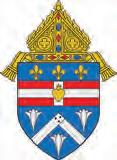


Sixth Bishop of Houma-Thibodaux.



CONGRATULATIONS
Bishop Simon Peter Engurait
Archbishop Samuel J. Aquila and Bishop Jorge Rodríguez wish to congratulate
Bishop Simon Peter Engurait on his installation to the Diocese of Houma-Thibodaux.
Many blessings on your ministry!






Archbishop Shelton Joseph Fabre together with the clergy, religious, and laity of the Archdiocese of Louisville express prayers and best wishes to Bishop Simon Peter Engurait as he begins his episcopal ministry in service to the People of God as Bishop of the Diocese of Houma-Thibodaux

Most Rev. Samuel J. Aquila Archbishop of Denver
Most Rev. Jorge Rodríguez Auxiliary Bishop of Denver
OUR SCHOOLS SHOW THEIR LOVE AND SUPPORT FOR BISHOP SIMON PETER
The ordination and installation of Bishop Simon Peter was not only a moment of joy for our parishes, but also for our Catholic schools. Many students and faculty were able to attend the celebrations in person, while others joined by livestream from their classrooms. Throughout the week, our schools lifted Bishop Simon Peter in prayer with daily school-wide prayers and rosaries, surrounding him with faith and love.
As a special tribute, our students also expressed their excitement and support of our new bishop through artwork. We are proud to share some of their beautiful creations here—a heartfelt reminder of the joy that our young Church brings to our diocese.















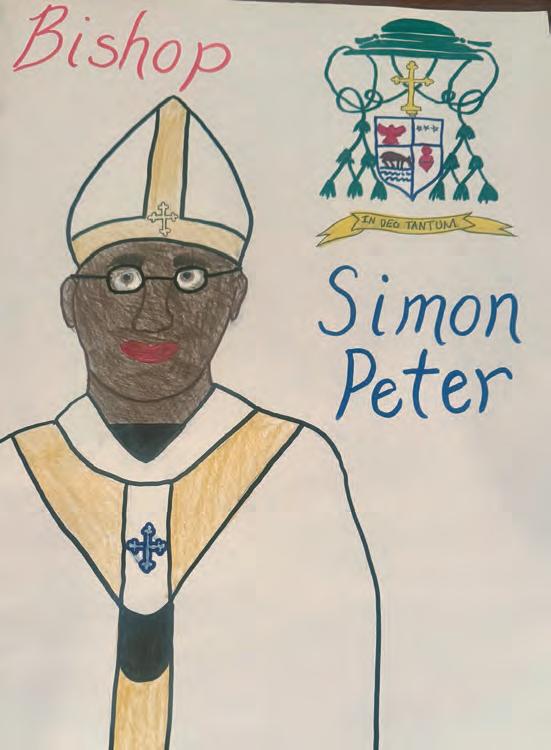


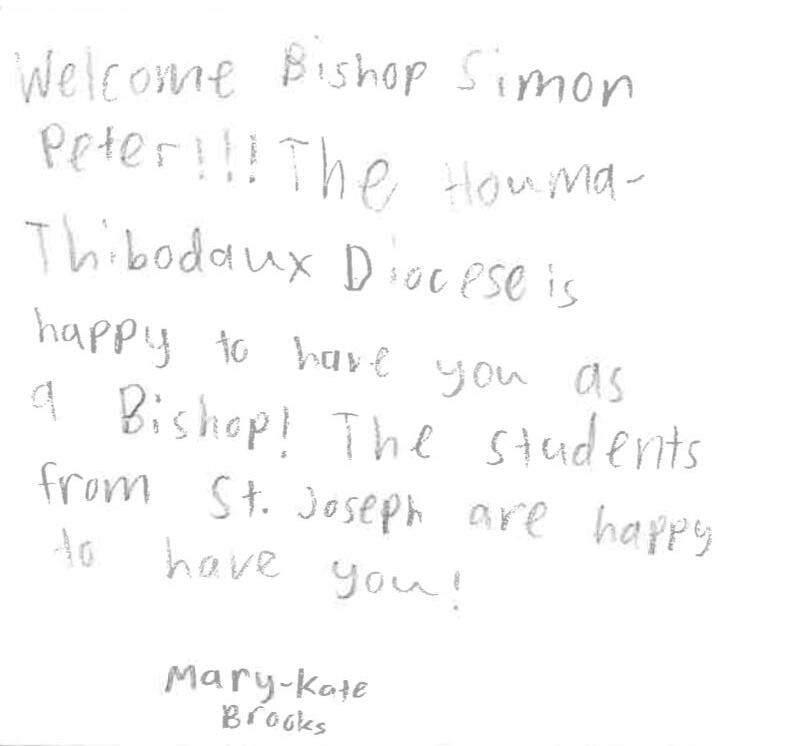




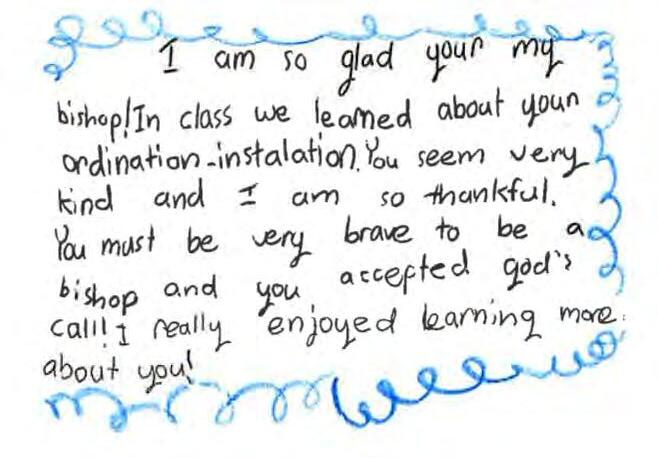








-TESA STARR STUDENT AT ST. FRANCIS

DIOCESE WELCOMES THREE NEW PRIESTS TO HOUMA-THIBODAUX
The Diocese of Houma-Thibodaux rejoices in welcoming three new priests who are sharing in the mission of ministering to God’s people here in South Louisiana. Each of them brings unique experiences, cultural backgrounds, and spiritual gifts, yet all are united by their deep love for Christ and His Church.

REV. JOSÉ ALBERTO JUÁREZ SANDOVAL, CSB HISPANIC MINISTRIES
Born in Puebla, Mexico, Fr. José grew up in a strong Catholic family where values of faith and service were deeply rooted. From a young age, he was known for his discipline and love for the Church, which eventually led him to encounter the Congregation of the Basilian Fathers during a vocational retreat.
His journey with the Basilians has taken him across Mexico, the United States, and Colombia. After professing his vows in 2012, he continued his studies in philosophy and theology and was ordained a priest in 2019 . He has served as pastor, formator, and missionary, most recently in Medellín, Colombia.
Now, he brings his pastoral heart and missionary spirit to Houma-Thibodaux. Fr. José Alberto has been touched by the warm welcome he’s received from Bishop Simon Peter and the faithful of the diocese, especially the Hispanic community. He says he is overjoyed to serve here and entrusts himself to the prayers of his new parish family.

REV. ALEX OKIROR
ST. GENEVIEVE CATHOLIC CHURCH
A native of Kidetok, Uganda, Fr. Alex is the second of ten children. At just 12 years old, he entered seminary and began a lifelong journey of formation that would take him from Uganda to Spain and eventually to Louisiana.
He was ordained a priest in 2014 and went on to specialize in Canon Law, earning advanced degrees in Spain. Fr. Alex has served in parishes both in his home Diocese of Soroti and in Madrid, combining parish ministry with his scholarly background.
Today, he serves as parochial vicar at St. Genevieve Catholic Church in Thibodaux, where he has already experienced the joy and vibrancy of the local faith community. “I feel at home here,” he said, “and I look forward to serving the people according to the heart of Jesus the High Priest.”
REV. OSMAN ENRIQUE DE LA HOZ ESCORCIA HISPANIC MINISTRIES
From Barranquilla, Colombia, Fr. Osman describes his life as one marked by respect, honesty, and service. After high school, he pursued culinary studies before discerning his call to the priesthood. In 2016 , he joined the Basilian Fathers and began formation, completing studies in philosophy and theology with honors.
Alongside his academic formation, he contributed to international theological congresses, reflecting his passion for study and evangelization. In 2023 , he professed perpetual vows, and in March 2024 he was ordained a deacon. He arrived in Houma-Thibodaux this past July, just months after his ordination to the priesthood in Bogotá in January 2025.
Fr. Osman said he is eager to share his skills, offer formation workshops, and support Bishop Simon Peter in pastoral initiatives. “I have felt very welcomed by the parishioners and priests of the diocese,” he shared. “It is a blessing to serve here.”

As these three priests begin their ministry among us, let us keep them in prayer. Their diverse backgrounds remind us of the universality of the Catholic Church, and their willingness to serve is a gift to our diocese.
May God bless Fr. José, Fr. Alex, and Fr. Osman as they minister with hearts on fie for Christ and His people.
WELCOMING OUR NEWEST SEMINARIANS
Congratulations to these three men who were recently accepted into their fist year of priestly formation at the St. Joseph the Worker Seminarian House of Formation in Thibodaux!
WILLIAM STEUBEN
William Steuben was accepted into his fist year of priestly formation in June of this year.
He is a lifelong resident of Thibodaux, having attended St. Joseph Catholic Elementary and E.D. White Catholic High School. He grew up in St. Joseph Co-Cathedral and St. Genevieve parishes. William studied allied health at Nicholls State University, where St. Thomas Aquinas Catholic Student Center became his spiritual home. In his free time, Will loves to work with leather, creating Bible covers, rosary pouches, and more.
“I am filled with nothing short of gratitude for my acceptance,” he shared. “I am most looking forward to learning how to be more virtuous and to see where the Lord may be calling me.”



CALEB SYLVEST
A lifelong resident of Thibodaux, Caleb Sylvest was accepted into his fist year of priestly formation in June.
He attended St. Genevieve Catholic Elementary and E.D. White Catholic High School, and he grew up in St. Charles Borromeo and St. Thomas Aquinas parishes. Caleb graduated from Nicholls State University with a bachelor’s degree in fiance. He fids joy in both listening to and playing music.
“Being accepted into priestly formation has felt both humbling and hopeful,” he said. “I’m especially looking forward to growing in prayer, living in community, and being shaped for whatever God is calling me to.”


CAIN LAMBERT
In August, Cain began his fist year of priestly formation. A lifelong resident of Lutcher, Cain attended St. Peter Chanel Catholic Elementary, Paulina Elementary, and Lutcher High School. He earned a bachelor’s degree in accounting from Southeastern Louisiana University and worked at First American Bank and Trust in Vacherie for three years. Cain grew up attending and serving at Sacred Heart of Jesus Catholic Church in Gramercy. In his free time, he enjoys playing tennis and spending time with friends.
Cain shared, “Entering into priestly formation has been a dream of mine for a few years now. I never thought this would be the year where that dream would become a reality. I am extremely grateful to be given this opportunity.”
Please keep these men, and all of our seminarians, in your prayers as they discern God’s will for their lives.

OCTOBER DAILY PRAYER
FOR PRIESTS, DEACONS, RELIGIOUS, AND SEMINARIANS
Oct 1: Bishop Simon Peter Engurait
Oct 2: Rev. Alexis (Alex) Lazarra
Oct 3: Rev. Peter Tai Le
Oct 4: Rev. Glenn LeCompte
Oct 5: Very Rev. Eric P. Leyble JCL
Oct 6: Rev. Joey Lirette
Oct 7: Very Rev. P.J. Madden, retired
Oct 8: Deacon Harold Fanguy, retired
Oct 9: Rev. Clyde Mahler, retired
Oct 10: Rev. Fernando Anaya Maida
Oct 11: Rev. John David Matherne
Oct 12: Sister Catherine Siracusa, O.S.B.
Oct 13: Very Rev. Andre’ Melancon, VF
Oct 14: Very Rev. Thankachan (John) Nambusseril, V.F.
Oct 15: Rev. Roch Naquin, retired
Oct 16: Deacon James LeFevre
Oct 17: Rev. Ty Nguyen, retired
Oct 18: Rev. Jean-Marie Nsambu
Oct 19: Rev. Alex Okiror
Oct 20: Rev. Charles Perkins
Oct 21: Rev. Joseph Pilola
Oct 22: Rev. Matthew Prosperie
Oct 23: Deacon Jesse LeCompte, retired
Oct 24: Rev. Patrick Riviere
Oct 25: Very Rev. Joshua Rodrigue
Oct 26: Rev. James Rome
Oct 27: Rev. Robert Rogers
Oct 28: Rev. Mitchel Semar
Oct 29: Rev. Glenn Porche, retired
Oct 30: Rev. Carlos Talavera
Oct 31: Bishop Emeritus Sam Jacobs

NOVEMBER DAILY PRAYER
FOR PRIESTS, DEACONS, RELIGIOUS, AND SEMINARIANS
Nov 1: Bishop Simon Peter Engurait
Nov 2: Rev. Wilmer Todd, retired
Nov 3: Seminarian Michael Robichaux
Nov 4: Rev. Mark Toups
Nov 5: Rev. Mike Tran, VF
Nov 6: Rev. Joseph Tregre
Nov 7: Rev. Khoa Dang, CRM
Nov 8: Rev. Augustine Ky Truong CRM
Nov 9: Deacon Chris Prestenback
Nov 10: Rev. Romeo (Billy) Velasco
Nov 11: Sister Mary Assumpta Thien Oanh Tran, F.M.S.R.
Nov 12: Deaco Jeff Pitre
Nov 13: Rev. Ronilo (Ron) Villamor
Nov 14: Deacon John Mattingly
Nov 15: Rev. Davis Ahimbisibwe
Nov 16: Very Rev. Jay L. Baker, MCL, JCL
Nov 17: Rev. Michael Bergeron, retired
Nov 18: Rev. Paul Birdsall
Nov 19: Sister Mary John of the Cross Trang Thi Luu, F.M.S.R.
Nov 20: Rev. Shenan Boquet
Nov 21: Seminarian Cain Lambert
Nov 22: Rev. Thomas R. Bouterie, retired
Nov 23: Deacon Timothy Vedros
Nov 24: Rev. Rusty Paul Bruce
Nov 25: Deacon Raymond Bourg, Jr., retired
Nov 26: Msgr. Frederic J. Brunet, retired
Nov 27: Rev. Stephen Castille
Nov 28: Rev. Joseph Chacko, I.M.S.
Nov 29: Deacon James Brunet, Jr.
Nov 30: Bishop Emeritus Sam Jacobs

DECEMBER DAILY PRAYER
FOR PRIESTS, DEACONS, RELIGIOUS, AND SEMINARIANS
Dec 1: Bishop Elect Simon Peter Engurait
Dec 2: Rev. Cody Chatagnier
Dec 3: Rev. Dean Danos, retired
Dec 4: Rev. Evelio (Toto) Buenaflor, Jr., retired
Dec 5: Rev. Carl Collins
Dec 6: Rev. Van Constant
Dec 7: Sister Miriam Therese Mire, C.S.J.
Dec 8: Rev. Domingo (Ding) Cruz, retired
Dec 9: Rev. Robert-Joel Cruz
Dec 10: Very Rev. Vicente N. DeLa Cruz, MCL, JCL, VF
Dec 11: Deacon Stephen Brunet
Dec 12: Rev. Wilfredo Decal, retired
Dec 13: Rev. Scott Dugas, retired
Dec 14: Jennifer Ely, Consecrated Virgin
Dec 15: Rev. Daniel Duplantis
Dec 16: Rev. Noas Kerketta
Dec 17: Rev. Msgr. Cletus Egbi
Dec 18: Deacon Sam Burregi, retired
Dec 19: Rev. Gregory Fratt, retired
Dec 20: Rev. Antonio Farrugia
Dec 21: Deacon Timothy White
Dec 22: Rev. Nathaniel Maria Gadalia
Dec 23: Deacon Larry Callais, retired
Dec 24: Rev. Alex Gaudet
Dec 25: Rev. Rholando (Rholly) Grecia
Dec 26: Seminarian Will Steuben
Dec 27: Rev. Varghese (Joe) Josekutty
Dec 28: Sister Mary Bernadette Trang-Tien Nguyen, F.M.S.R.
Dec 29: Rev. Brice Higginbotham
Dec 30: Rev. Francis Kayaye
Dec 31: Bishop Emeritus Sam Jacobs

LITURGICAL CALENDAR
Oct 1: Memorial of St. Therese of the Child Jesus
Oct 2: Memorial of the Holy Guardian Angels
Oct 4: Memorial of St. Francis of Assisi
Oct 7: Memorial of Our Lady of the Rosary
Oct 15: Memorial of St. Teresa of Jesus
Oct 17: Memorial of St. Ignatius of Antioch
Oct 18: Feast of St. Luke
Oct 28: Feast of Sts. Simon and Jude
Nov 1: Solemnity of All Saints
Nov 2: All Souls’ Day
Nov 4: Memorial of St. Charles Borromeo
Nov 9: Feast of the Dedication of the Lateran Basilica
Nov 10: Memorial of St. Leo the Great
Nov 11: Memorial of St. Martin of Tours
Nov 12: Memorial of St. Josaphat
Nov 13: Memorial of St. Frances Xavier Cabrini
Nov 17: Memorial of St. Elizabeth of Hungary
Nov 21: Memorial of The Presentation of the Blessed Virgin Mary
Nov 22: Memorial of St. Cecilia
Nov 23: Solemnity of Our Lord Jesus Christ, King of the Universe
Nov 24: Memorial of Saint Andrew Dũng-Lạc and Companions
Nov 30: First Sunday of Advent
Dec 3: Memorial of St. Francis Xavier
Dec 8: Solemnity of the Immaculate Conception of the Blessed Virgin Mary (Holy Day of Obligation)
Dec 12: Feast of Our Lady of Guadalupe
Dec 13: Memorial of St. Lucy
Dec 25: Solemnity of the Nativity of the Lord (Holy Day of Obligation)
Dec 26: Feast of St. Stephen
Dec 27: Feast of St. John
Dec 28: Feast of The Holy Family of Jesus, Mary, and Joseph
DATES FROM THE USCCB LITURGICAL CALENDAR FOR THE DIOCESES OF THE UNITED STATES OF AMERICA 2025
The Diocese of Houma-Thibodaux remembers Fr. Roger Eugene Villarrubia, Jr., affectionately known as Fr. Jerry, who passed away on Thursday, June 12, 2025 at the age of 96. Born on June 6, 1929, in New Orleans, Louisiana, Fr. Jerry had called Houma home since 1959, touching the lives of countless parishioners over the decades.
Before his calling to the priesthood, Fr. Jerry shared 35 years of marriage with his beloved wife, Marie “Lee” Richard, and was the devoted father of seven children. Even after the heartbreaking loss of his wife to cancer, Fr. Jerry was ordained a Roman Catholic priest on May 22, 1999 (eight years later). He served the Diocese of HoumaThibodaux for the next 26 years.
IN MEMORY OF FR. ROGER VILLARRUBIA, JR. WELL
Fr. Jerry is survived by his seven children: John Steven Villarrubia (Maria Villarrubia), Paul Gerard Villarrubia (Cindy Villarrubia), Cecile M. Babin (Chris Babin), Maria A. Bordelon (Wayne Bordelon, Jr.), Jerome Peter Villarrubia, Ann C. Prejean, and Jude Michael Villarrubia, as well as 19 grandchildren and 16 great-grandchildren. He was preceded in death by his parents, Roger E. Villarrubia, Sr. and Celuta Marie Tete; by his wife, Marie “Lee” Richard; by his infant son, Mark Allen Villarrubia; and by six siblings.
A visitation and burial were held on Saturday, June 21, 2025 at Maria Immacolata Catholic Church in Houma, Louisiana, with interment at St. Louis Cemetery No. 3 in New Orleans, Louisiana.
We pray for the repose of Fr. Jerry’s soul and for his family. We are forever grateful for his service and unwavering faith. Though he is deeply missed, his spirit continues to inspire all who knew him.
Sources: https://www.chauvinfuneralhome.com/obituaries/ roger-villarrubia-jr

-MATTHEW 25:23

MEET OUR NEWEST SAINTS: SAINTS CARLO ACUTIS
& PIER GIORGIO FRASSATI
BY: BEVI FONTENOT
This past September 7, Pope Leo XIV canonized two extraordinary young Italians—Saint Carlo Acutis and Saint Pier Giorgio Frassati—marking them as inspirational figures for our times. The celebration drew an estimated 70,000–80,000 pilgrims to St. Peter’s Square.
WHO IS SAINT CARLO ACUTIS?
Known as “God’s Influencer,” Carlo Acutis (1991–2006) is the fist millennial saint in Church history. A tech-savvy teenager from Milan, Carlo used his computer skills to build an acclaimed multilingual website showcasing Eucharistic miracles—offering digital evangelization long before it was commonplace.
Despite battling leukemia, Carlo remained deeply devoted, limiting his screen time to prioritize prayer and relationships. His ordinary pursuits like playing video games and spending time with friends made him relatable, and he’s become an inspiring model for young Catholics navigating faith in the digital age.
WHO IS SAINT PIER GIORGIO FRASSATI?
Pier Giorgio Frassati (1901–1925 ) was an Italian layman recognized for his dynamic faith and social outreach. A member of the Third Order of St. Dominic, he joined Catholic Action and the Society of St. Vincent de Paul, dedicating his life to helping the poor in Turin. He was beatified by Pope John Paul II and is often called the “Man of the Eight Beatitudes.” On September 7, 2025, he was formally canonized alongside Carlo Acutis.



A POWERFUL MESSAGE FOR TODAY’S CHURCH
At the canonization Mass, Pope Leo XIV urged all faithful—especially the young—to follow the saints’ examples of fearless faith and charity. He called their lives “masterpieces” born from complete devotion to God and encouraged us not to “squander our lives” but to dedicate them fully to His plan.
WHY THESE SAINTS MATTER TO US
Spiritual Relevance: Carlo bridges traditional faith with modern technology. Pier Giorgio models authentic, active compassion.
Youthful Witness: Both offer inspiring testimonies for young people: Carlo in the digital world, Pier Giorgio in service and social justice.
A Call to Action: They challenge us to use our talents—whether tech-savvy or hands-on—to glorify God and serve others.
The feast day of Saint Carlo Acutis will be celebrated annually on October 12 , and the feast day of St. Pier Giorgio will be celebrated on July 4, the anniversaries of their deaths, respectively.
We rejoice in their canonizations, and pray that their example may inspire us to live our faith more boldly.
ST. CARLO ACUTIS AND ST. PIER GIORGIO
FRASSATI, PRAY FOR US.






HOW
CAN YOU RECEIVE A PLENARY INDULGENCE THIS JUBILEE YEAR OF HOPE?

On Thursday, May 9, 2024, the Solemnity of the Ascension of the Lord, Pope Francis officially proclaimed the Ordinary Jubilee of 2025 with the public reading and delivery of the Bull of Indiction for the Jubilee Holy Year 2025 , in Saint Peter’s Basilica at the Vatican.
The Jubilee Year officially kicked off on December 29, 2024 and will continue until December 28, 2025.
But what exactly is a Jubilee Year, and how do you participate?
WHAT IS A JUBILEE YEAR?
First seen in the Bible, Jubilee Years were a special 50 th year in ancient Israel, proclaimed by a trumpet blast on the Day of Atonement as described in Leviticus 25 , where all Israelite slaves were freed, debts were forgiven, and ancestral land was returned to its original owners.
The tradition has evolved over time. In modern times, Jubilee years are typically celebrated every 25 years as a special time of prayer, conversion and acts of charity. Pope Francis declared an extraordinary Jubilee in 2015–2016, but those are rare. Looking at the calendar, unless an extraordinary Jubilee is declared, that means the next one will be in 2050!
WHAT IS A PLENARY INDULGENCE?
During a Jubilee Year, the Church offers a rare and powerful opportunity to receive an extraordinary spiritual gift: a plenary indulgence—the complete removal of temporal punishment due to sin, either for yourself or a deceased loved one. And you can get one every single day until the end of the Jubilee!
A plenary indulgence is the full remission of the temporal punishment due to sin. Temporal punishment is the damage done to our souls that remains even after we’ve been forgiven, and Purgatory is the place or process where temporal punishment is purified after death.
Indulgences don’t forgive sin itself, but they heal the damage done to our souls which would normally be healed in Purgatory. Confession is the only ordinary way that mortal sins are forgiven.
A plenary indulgence can be gained once per day and can be applied either for oneself or for a soul currently in Purgatory.
As theologian Dr. Johyn Bergsma explains, “Purgatory is merciful and necessary for a departed soul to become completely detached from sin and made pure; however, in a way, it is sad and entirely unnecessary, since Christ and His Church give us ample opportunities to rectify this payment on earth; if we sincerely make use of them. These opportunities are indulgences” (Jesus and the Jubilee: The Biblical Roots of God’s Favor, p. 129).
HOW DO YOU RECEIVE A PLENARY INDULGENCE?
Here are simple steps that you can follow to obtain a plenary indulgence this year:
1. Go to confession twenty days before or after the day the indulgence is sought.
2. Receive Holy Communion.
3. Pray for the intentions of Pope Leo XIV (a recited prayer works!)
4. Spend 15 minutes or more in adoration.
5. Conclude your adoration time with an Our Father, a Marian prayer, and a Profession of Faith.
6. In addition, perform one of the three “works” below:
Option 1: Visit one of the churches designated as sacred pilgrimage sites. Those sites in our diocese are:
• Cathedral of St. Francis de Sales (Houma)
• St. Joseph Co-Cathedral (Thibodaux)
• Parish Church of Sacred Heart (Morgan City)
• Parish Church of Sacred Heart (Montegut)
• Parish Church of Sacred Heart (Cut Off
Option 2: Participate in a mission, retreat, or formation activity on the documents of Vatican II and the Catechism of the Catholic Church (such as an episode from Bishop Robert Barron’s Catholicism series or Father Mike Schmitz’s Catechism in a Year podcast)
Option 3: Visit brothers and sisters who are in need or in difficulty such as the sick, imprisoned, elderly or disabled
Pilgrims may obtain the Plenary Jubilee Indulgence until the Feast of the Holy Family on December 28, 2025. The Jubilee Year officially began on December 29.
DON’T MISS THIS GRACE
The Jubilee Year is a beautiful opportunity to encounter God’s mercy in a profound way. Whether you make a pilgrimage, serve a neighbor in need, or work to deepen your formation, you can receive this extraordinary gift of grace again and again.

DIOCESAN EVENT RECAPS
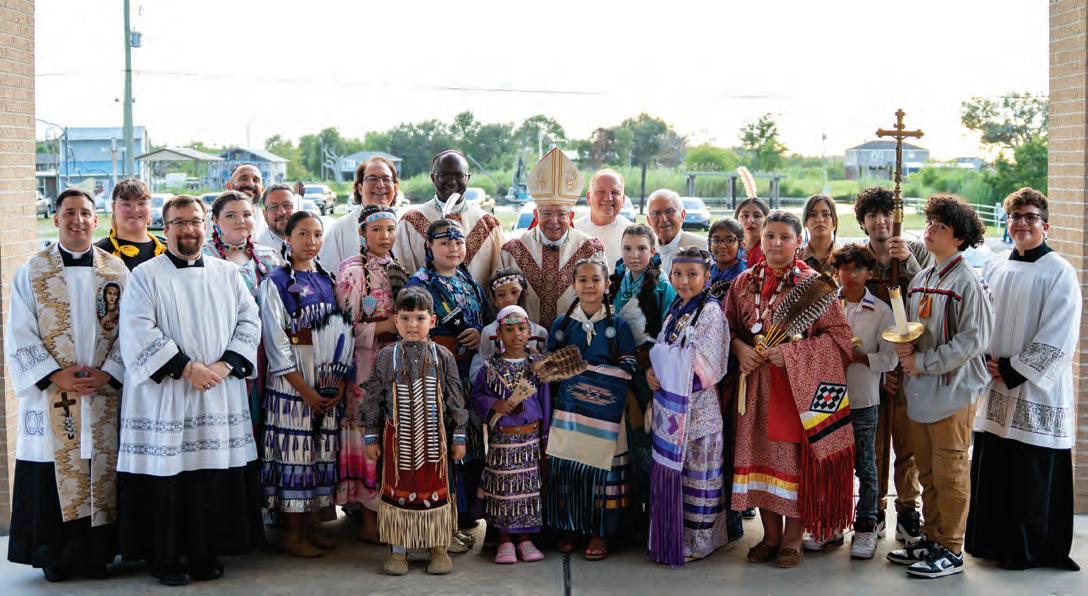

AMERICAN INDIAN MINISTRY CELEBRATES ST. KATERI MEMORIAL MASS
On July 11, the diocese held a beautiful 30th annual Memorial Mass in honor of St. Kateri Tekakwitha at Holy Family Church in Dulac as we celebrated the American Indian ministry in our diocese!
Bishop Sam Jacobs presided at this Mass, with Bishop Simon Peter Engurait, Father Roch Naquin (retired), Father Antonio Farrugia and Father Rusty Bruce. Thank you to our American Indian Ministry and our Knights of Columbus and Knights of Peter Claver.
Known as the “Lily of the Mohawks,” St. Kateri is the patron saint of ecology, the environment, and Native Americans. She is remembered for her deep devotion to Christ and her commitment to charity and chastity.
As we celebrate her legacy, we pray for all Native American peoples in our Catholic community and for the preservation of their rich cultural heritage. Learn more about the American Indian Ministry in our diocese at htdiocese.org/nativeamerican-catholics.
St. Kateri Tekakwitha, pray for us.
DIOCESE GAINS A NEW PERMANENT DEACON
On Saturday, August 2 , Deacon James LaJaunie, Jr. was ordained to the Permanent Diaconate by Bishop Emeritus Sam Jacobs on Saturday at St. Joseph Co-Cathedral.
We are grateful for his “yes” to a life of service in the Church. Bishop-Elect Simon Peter Engurait has assigned Deacon James to serve at his home parish of St. Joseph Co-Cathedral.
Please join us in praying for Deacon James as he begins his ministry!


ST. MARY’S NATIVITY CELEBRATES 175TH ANNIVERSARY
On Sunday, August 3 , St. Mary’s Nativity parish celebrated its 175th anniversary! Bishop-Elect Simon Peter Engurait, administrator Fr. Joseph Tregre, former pastors Fr. Clyde Mahler and Fr. Charles Perkins, and former associate pastor Fr. Dot Pham joined in this milestone celebration and Mass.
At this special celebration, a new shrine was blessed on the site where the old rectory once stood. It features the beautifully-restored statue of the Blessed Mother and Child—a cherished piece originally donated in 1931 by Mrs. L.M. Toups, Sr. The shrine was the vision of parishioner Eric Ordoyne, who thoughtfully constructed it using bricks salvaged from the former rectory.
Congratulations to our parishioners of St. Mary’s Nativity on 175 years of faith! Thank you to all who have been a part of this legacy.

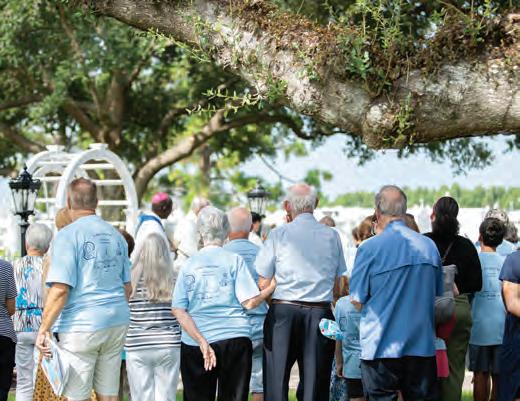
SEMINARIAN ETHAN HENRY IS ACCEPTED INTO CONFIGURATION PHASE
On Saturday, August 2 , a Candidacy Mass was held for seminarian Ethan Henry at St. Thomas Aquinas Catholic Church in Thibodaux. This Mass, celebrated by Bishop Simon Peter, represented Ethan’s acceptance by Bishop and the Church into the next phase of seminarian formation—the configuration stage! Think of it like a marriage engagement!
Father Mitch Semar, Director of the Office of Vocations, gave a lovely and inspiring homily.
Let us continue to pray for Ethan, and all of our seminarians, especially those in a period of transition. Grant them peace, clarity and focus as they continue on this journey to the priesthood.

DIOCESE CELEBRATES ASSUMPTION OF MARY WITH ACADIAN CULTURAL MASS
On Friday, August 15, the diocese hosted an Acadian Cultural Mass for the Solemnity of the Assumption of the Blessed Virgin Mass at St. Hilary of Poitiers Catholic Church in Raceland. It was a lovely event for all ages to come together to honor Mary and rejoice in the culture that makes our diocese home. A fun reception included Cajun food and music from LA Rose. We appreciate all who made this event possible!

PERPETUAL VOWS OF SISTER JACINTA
A beautiful Mass was celebrated by Bishop Simon Peter on Friday, August 22 at St. Joseph Co-Cathedral for the perpetual vows of Sister Jacinta Maria in the Little Friars and Little Nuns of Jesus and Mary!
“This is a very special celebration, not just for Sr. Jacinta, but for all of us,” said Bishop-Elect Simon Peter Engurait. “Religious life is a manifestation of the love and saving presence of God in our midst. What she promises—chastity, poverty and obedience—make no sense unless Heaven is real and God is truly the treasure worth giving everything up for. We rejoice not only in the gift, but in a God who calls.”
Congratulations to Sr. Jacinta! Our prayers are with you as you continue this journey.

A GREAT START TO THE 2025-2026 SCHOOL YEAR
Students, teachers, and pastors of our Catholic schools were all smiles on their fist days at school. Teachers also participated in our Educator’s Convocation held at Vandebilt Catholic High School on Friday, August 1 to gear up for the year ahead. We are grateful for our teachers, staff, students and parents who work together to make our schools a better place academically and spiritually, everyday!



2025 HOPE OF GLORY SUMMIT FOR YOUTH MENTORS
This summer, our Office of Parish Support hosted youth leaders from across our diocese for the 2025 Hope of Glory Summit, a weekend of prayer, formation, and fellowship.
Rooted in the post-resurrection stories of Jesus, the Summit reminded us: Christ doesn’t just meet us at the destination—He walks with us along the way.
From Adoration to small group discussions, our mentors left renewed in their mission to form missionary disciples. “We’re not just running programs—we’re leading souls to Christ.”
Join us in praying for all who walk with our young Church! Thank you to our OPS team for their work in making this event possible.


TOMMY MEYER: LEADERSHIP, LEGACY, FAITH, AND COMMUNITY IMPACT
TOMMY MEYER: LEADERSHIP, LEGACY, FAITH, AND COMMUNITY IMPACT

At the helm of Meyer Financial Group stands Private Wealth Advisor Tommy Meyer, a leader whose vision combines professional excellence, deep faith, and a heartfelt dedication to family and community. Supported by a talented team, Tommy has built a practice defined by trust, integrity, and partnership. From the beginning, his mission has been clear: to walk alongside families through every stage of life, ensuring they are equipped with the tools, knowledge, and strategies to reach their goals. At Meyer Financial Group, the client relationship does not end with a single meeting or transaction—it is a lifelong partnership rooted in care, guidance, and stewardship.
The firm offers a comprehensive suite of services tailored to meet the diverse needs of individuals, families, and businesses across South Louisiana. These services include investment management, retirement planning, estate planning, risk management, and multigenerational wealth planning. By taking the time to understand each client’s story, the advisors at Meyer Financial Group provide more than numbers and charts—they deliver clarity, peace of mind, and a vision for the future. Whether it is guiding young professionals as they begin to build their financial foundation, helping families prepare for college expenses, or ensuring retirees can enjoy their golden years with security, Tommy and his team view every plan as a personalized roadmap designed to evolve as life changes.
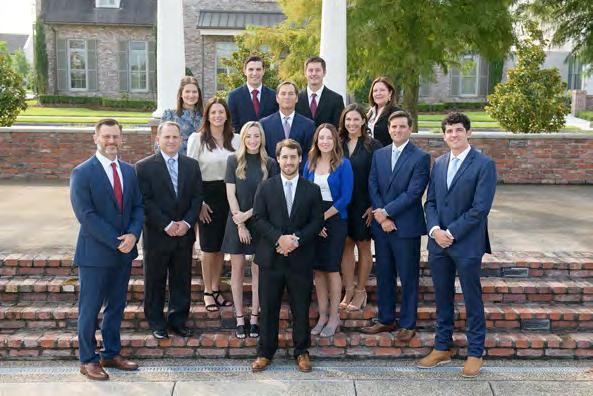
A hallmark of Meyer Financial Group’s approach is its commitment to multigenerational planning. Tommy and his advisors work not only with clients today but also with their children and grandchildren to help preserve family values and wealth across decades. This philosophy of walking alongside families as they grow and change is what makes Meyer Financial Group more than a financial firm—it is a trusted partner in life’s journey. For Tommy, this dedication is sustained by his deep Catholic faith, which serves as the foundation of his leadership. His faith inspires him to treat every client relationship as a vocation rooted in service and stewardship, always striving to reflect the values of compassion, integrity, and generosity.
Tommy’s passion for service extends well beyond his professional practice. In 2016, he and his family established the Ben Meyer Foundation in honor of his brother, Ben Meyer. The foundation was created to reflect Ben’s love for youth, the arts, and community, and it has grown into a beacon of hope and generosity for the region. Its flagship event, Acadia Music Fest, has blossomed into one of South Louisiana’s most anticipated cultural festivals. Every October, more than 6,000 attendees gather in Thibodaux to enjoy a day filled with world-class music, Louisiana cuisine, and fellowship. But beneath the vibrant celebration lies a deeper purpose: to raise critical funds for organizations meeting urgent community needs.

The impact of Acadia Music Fest has been profound. Over the years, the event has supported nonprofits such as Beyond the Bell, Riley John’s Blue Boot Foundation, Bridge to Independence, Louis Children’s Crisis Center, CASA of Lafourche, McDonnell House, Max Charter School, Upside Downs, and Hi-5. In 2025, the festival will benefit the Camille A. Morvant Children’s Advocacy Center of Lafourche, which provides life-changing support for children and families affected by trauma and abuse. By channeling the energy of music and culture into charitable action, the festival has become a powerful expression of the Meyer family’s belief in giving back and strengthening the community.
For Tommy, these endeavors—whether financial planning or philanthropy— are united by a single vision: building a stronger, more hopeful future. He relies daily on his faith to guide his decisions, sustain his perseverance, and keep his focus on serving others. Every client meeting, every festival, and every partnership is an opportunity to live out his values by helping families achieve their dreams, supporting organizations that uplift the vulnerable, and honoring his brother Ben’s legacy. Through Meyer Financial Group, the Ben Meyer Foundation, and Acadia Music Fest, Tommy Meyer has become a driving force in South Louisiana—walking alongside families, investing in his community, and leading with faith at the center of it all.

FAITH LIKE A CHILD:
A MOTHER’S JOURNEY TO BECOME CATHOLIC
BY: BEVI FONTENOT
At this year’s Easter Vigil, Britney Johnson of Chackbay was welcomed into the Catholic Church at St. Joseph Co-Cathedral in Thibodaux. Her story reminds us that we never stop learning, and God never stops calling us home.
IT STARTS WITH A SINGLE DROP
Britney grew up in Lafayette, Louisiana. As a child, she recalls attending Mass only a handful of times. “We were always very busy with sports, and I only remember going to a Catholic church a few times,” she said. Yet, each time she went, she felt uplifted—an experience that stayed with her and shaped her perspective into adulthood.
That sense of curiosity stayed with her into her college years. She visited different churches, searching for a spiritual home, but never found one that stuck. It wasn’t until the birth of her daughter, Parker, that everything changed.
“Once I had Parker, I realized I wanted her to have a religious foundation,” Britney said. “I wanted Parker to learn to always lean on God during hardship, and that no mountain is too high for our God,” Britney explained. “As her faith would grow, her fears would lessen.”
A RIPPLE OF JOY AND WONDER
Parker and Britney moved to Chackbay shortly after Parker’s birth. When Parker was five, she began attending St. Joseph Catholic Elementary School in Thibodaux, where she truly started to learn about God and the Catholic faith. She loved Bible stories and discovering how to pray. Each day, she was bursting with excitement to share what she had learned with Britney.
“She would tell me about the stories she was learning from the Bible, about a sneaky snake and a burning bush. She would ask me if I knew the stories and the prayers, and to be honest, I didn’t,” Britney admitted. “But she was excited, and I was listening.”
Seeing Parker’s enthusiasm for her faith stirred within Britney’s heart a resolve to raise Parker Catholic. Soon thereafter, she had Parker baptized in the Catholic Church.
Raising Parker as a Catholic caused Britney to reflect on her own faith journey. Parker’s excitement piqued Britney’s interest in exploring her faith and living it more deeply. “I didn’t want Parker to grow and not see me following through. How could I ask her to live out her Catholic faith if I wasn’t willing to live it as well?”
Attending the school Mass, Britney was reminded of the beauty of the liturgy. “It’s so heartwarming to see kids participating; I loved it.” She particularly felt a tug in her own heart. But she was hesitant because it was something new, and she was afraid to admit that she would be starting from ground zero. “It was something I really wanted,” she said, “but I was nervous. After every Mass, I felt clarity, and that feeling outweighed the fear.”
Britney felt that confidence and love every time she attended Mass. “That’s when I knew that God was leading me to do this,” she explained.
A WAVE OF FAITH AND COURAGE
Parker’s enthusiasm gave Britney the gentle push she needed to take the next step in her faith journey. She reached out to St. Joseph Co-Cathedral to inquire about the Rite of Christian Initiation of Adults (RCIA) program. “I didn’t know anyone at St. Joseph, so it felt uncomfortable at fist. But they welcomed me with open arms. I felt the weight of the unknown lifted. I knew I was making the right choice.”
Although the sessions had already begun, Pamela Folse, Coordinator of Adult Formation, offered to meet with her every Saturday to help catch her up. She would also attend Mass with the RCIA group on Sunday. Parker went along with Britney each week, and they learned side by side, laying a beautiful foundation of faith together. They started at the beginning, learning the basics, like the Holy Trinity. They practiced reciting prayers like the Glory Be. “Parker asked, ‘Mom, you don’t know this yet?’”
she laughed. Parker unknowingly but consistently helped her mom with prayers and practices along her journey.
Britney’s eyes were opened to the beauty of the Church. “When you’re raised in it, it can be routine. For me, it was new and exciting. Hearing Parker explain what she learned that day, and how she could use it in her everyday life, taught me that I can sometimes take a note from her book,” she reflected. Through Parker, she saw the Scriptures through the eyes of a child. “We were learning together.”
Britney also enjoyed learning alongside others in the RCIA group as they worked toward a common goal. “Everyone shared their personal stories. We would discuss the Gospel together and how each of us related to it.” She also recalled how meaningful it was to receive cards from parishioners at St. Joseph Church at the RCIA retreat. They offered encouragement and some shared their own experiences from the RCIA program.
Britney’s sponsor and co-worker (and now godparent!), Brittany Martin, was a big part of her journey, and they shared faith openly. “I would listen to the Bible in a Year podcast and return to work with so many questions! She helped me understand so much.” She supported Britney every step of the way. “She went to Mass with her family— and then again with me. She was completely committed to helping me do this.”
Britney’s friends and family were overjoyed about her decision. But many people were intrigued by her decision. They’d ask, “Why Now?” or “Why Catholic?” Over time, Britney grew confident in explaining her choice, and she learned how to answer common questions, such as those about Mary and the saints. She shared, “I prefer the structure of the Catholic religion. I learned that there are intentions and reasons behind all the movements and the prayers, and that made me respect the religion even more.” When studying the saints, she selected St. Christopher as her confirmtion saint because she was inspired by his faith and conversion story. The patron saint of travelers, she trusts him to guide her on the right path.
Something special that Britney really appreciated during the process was that she was included in the intentions every weekend at Mass at St. Joseph. “I didn’t expect to be called up every week and prayed for. It was so special because I felt like the whole Church was walking with me.” There were even times when members of the church would introduce themselves and wish her well during the process. Those small tokens of kindness showed her the beauty of the community of St. Joseph Church.
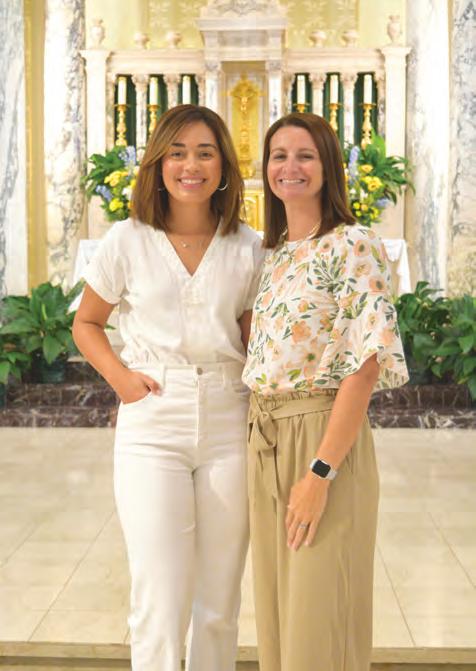

WHEN WE BEGIN TO INTRODUCE GOD INTO OUR DAILY CONVERSATIONS, OUR FAITH GROWS AND REACHES OTHERS. ” “
A FOUNTAIN OF FAITH
At the Easter Vigil, Britney was baptized, confired, and received the Eucharist for the fist time. She describes that night in one word— fulfilling. Now in full communion with the church, Britney feels happy and at peace. “I worked hard to learn and was committed to the process, so it feels really good,” she said.
Parker is now six and in fist grade at St. Joseph. They continue to enjoy learning and praying together. “Her nightly prayer is the Our Father, her favorite,” said Britney. “We read her religion notes, practice prayers, say our intentions and discuss how we can care for others.” Britney is excited for Parker to experience the sacraments and to live her life as a Catholic. And now they can continue to share their journey together.
The ripple effect of Britney’s decision has been powerful. Some members of her family have been inspired to return to church, and others have grown more curious about the Catholic faith. But it all started with Parker! A child’s faith can truly inspire an entire family.
For those exploring the Catholic faith, Britney offers this advice: “Speak about God out loud, to friends, family, or co-workers. The world makes us believe that we’re all different. But when we begin to introduce God into our daily conversations, our faith grows and reaches others.” She added, “What I wanted for my daughter initiated the process, but Brittany Martin guided and taught me along the way. Ms. Pamela spent extra with me to discuss our God, and the RCIA members that grew into friends made the process an unforgettable experience. I’m so thankful for every one of them.”
Today, Britney feels fully alive in her faith! She has a renewed sense of confidence, peace, and love every time she attends Mass. Her journey shows that God often calls us in unexpected ways, and that the faith of a child can lead anyone to Jesus. Hand in hand, Britney and Parker are inspirations to us all, reminding us that our Catholic faith is not only learned, but lived and shared across generations.
If you are interested in learning more about RCIA, contact your local church parish.
VETERANS DAY: A LEGACY OF SERVICE, COURAGE, AND FAITH
BY: JOE O’SULLIVAN

Every November 11, our nation pauses to honor the men and women who have worn the uniform in the United States Military. Unlike Memorial Day, which honors the fallen in military service, and Armed Forces Day, which honors those currently serving in the military, Veterans Day belongs to all who answered the call to serve in the U.S. Military.
THE HISTORY OF VETERANS DAY
Veterans Day was fist declared as “Armistice Day” in 1919 by U.S. President Woodrow Wilson. It served as a day of remembrance for those who served in WWI. A few decades later, in 1938 , the U.S. Congress voted to make Armistice Day a legal holiday. They decided to dedicate it not only to past service members of WWI, but also to world peace.
In 1954, after World War II had required the largest mobilization of soldiers, sailors, Marines, and airmen in history, Congress voted to change the name of “Armistice Day” to “Veterans Day” so they could broaden its focus
from WWI veterans to all veterans. Later that same year, President Dwight D. Eisenhower issued the fist “Veterans Day Proclamation.” As he charged Americans at that time, “I call upon all of our citizens to observe Thursday, November 11, 1954, as Veterans Day. On that day, let us solemnly remember the sacrifices of all those who fought so valiantly, on the seas, in the air, and on foreign shores, to preserve our heritage of freedom, and let us reconsecrate ourselves to the task of promoting an enduring peace so that their efforts shall not have been in vain.”
VETERANS DAY HAS CATHOLIC ROOTS
Veterans Day happens to fall on the Feast Day of St. Martin of Tours, although many believe this is not a coincidence!
St. Martin was a Roman soldier in the early 4th century. Born shortly after the legalization of Christianity in the Roman Empire, he received the sacrament of Baptism around the age of 10 , despite his parents being pagan.
When he was roughly 15 years old, St. Martin was conscripted into the military where he would follow his father’s footsteps. By the time he was 18, he was believed to have served all over much of modern-day Europe. However, something happened that would dramatically alter the course of his life.
When he was a young man, he encountered a beggar who was unclothed and practically freezing to death. Martin took compassion on him and cut his cloak in half to share with the beggar. That night, Martin had a dream where Christ revealed himself as the beggar who had come to him. As he came to reflect on the event, he decided he would no longer fight in the military and informed his superiors. Instead, he would “fight” for Jesus Christ and his Church. He would eventually go on to study under St. Hilary of Poitiers, open monasteries, and later become the Bishop of Tours in France.
Fittingly, the Armistice ending World War I was signed on November 11, 1918, ending the worst and most destructive war in history up to that point. Given his enduring popularity in Europe—and France in particular, where
he had been considered one of its great patrons for centuries—the timing of the Armistice was not lost on Europeans, and certainly not on the French.
He is the patron saint of soldiers, veterans, the poor, and a principal patron of France, among other patronages. The Church encourages all soldiers and veterans to take up devotion to St. Martin of Tours with their needs, concerns, and requests.
And just as St. Martin of Tours showed courage and holiness in his own day, so too have Catholic chaplains in modern wars.
FIVE CATHOLICS WITH MEDALS OF HONOR
It’s important to recognize faithful Catholics who have risen above and beyond the call of duty not just for their fellow service members, but also in their faith life. They are examples to all of us of tremendous courage and love in the face of extreme circumstances.

There are five Catholic Military Chaplains who have received the Medal of Honor—the highest military honor bestowed on individual service members. The Medal of Honor is “authorized for any military service member who ‘distinguishes himself conspicuously by gallantry and intrepidity at the risk of his [or her] life above and beyond the call of duty.’” The following Catholic chaplains have been recipients for the medal of honor:
Fr. Joseph T. O’Callahan, S.J. (World War II – Pacific/ Japan, 1946). A Jesuit priest and Navy chaplain, he fearlessly organized fiefighting and rescue efforts aboard the burning USS Franklin after a Japanese attack in 1945, personally saving countless lives amid explosions.
Fr. Emil J. Kapaun (Korean War – Korea, 2013 ). An Army chaplain from Kansas, he ministered tirelessly to fellow POWs after capture in 1950 —stealing food, offering prayers, and strengthening morale—until his death from maltreatment in 1951.
Fr. Vincent R. Capodanno, M.M. (Vietnam War – Republic of Vietnam, 1969). A Maryknoll missionary priest serving Marines, he was killed in 1967 while crawling through heavy fie to anoint and comfort wounded Marines, shielding one with his own body.
Fr. Charles J. Watters (Vietnam War – Republic of Vietnam, 1969). An Army chaplain from New Jersey, he repeatedly rushed into enemy fie during the Battle of Dak To in 1967 to carry wounded soldiers to safety and administer last rites, ultimately losing his life in action.
Fr. Angelo J. (Charles) Liteky (Vietnam War – Republic of Vietnam, 1969). An Army chaplain, he crawled into enemy fie more than 20 times in one battle, rescuing over 20 wounded soldiers.
While the Catholic Church has always taught that war is a tragic failure of peace, she also recognizes the acts of heroism, service, and patriotism that demonstrate the highest human qualities. In fact, hundreds of Catholic saints and beatified persons are connected to military life.
Of course, not all veterans receive recognition for their courage—and not all wounds are visible.
WHEN VETERANS COME HOME
The transition back to civilian life is not always an easy one. Studies show that veterans’ vocational, fiancial, and social well-being are at risk in the months and years following their return home from service, which tragically includes suicidal ideation. Veterans may also experience re-integration stress when they return home, fiding it more difficult to

WITHOUT THEM,
WE WOULDN’T BE ABLE TO ENJOY OUR RIGHT TO “LIFE, LIBERTY, AND THE PURSUIT OF HAPPINESS.”

fid employment, re-enter regular social life, or form and maintain new relationships. Many veterans carry their burdens in silence, often suffering complex trauma and mental health issues like Post-Traumatic Stress Disorder (PTSD) that extend far beyond their time in service. It remains more important than ever that we ensure veterans are supported when they return home.
VETERANS IN THE DIOCESE OF HOUMA-THIBODAUX
Roughly 4.5-6% of the population in the Diocese of Houma-Thibodaux is comprised of Veterans. This consists of St. Mary, Terrebonne, Lafourche, and Assumption Parishes, along with the lower bayou region of Jefferson Parish, including Grand Isle. And it is our duty to honor them and care for them.
CLOSING THOUGHTS
Veterans Day reminds us that the freedoms we enjoy come at a price. As Catholics, we see in their sacrifice a reflection of Christ’s own self-giving love. While we commemorate those who lost their lives on Memorial Day, it’s just as important to show honor to those who live in our neighborhoods, sit in the pews next to us, and shop at our grocery stores. Without them, we wouldn’t be able to enjoy our right to “life, liberty, and the pursuit of happiness.”
This November 11, may we remember their service not just in thought, but in deed. A small gesture of kindness and gratitude can be a simple and powerful way to let our veterans know we appreciate them. In the spirit of St. Martin, may we always welcome them back into our communities with the embrace of Christ.
To our veterans, thank you for your service to the United States, to Louisiana, and to us. We’re glad you’re home.
Sources: https://department.va.gov https://www.presidency.ucsb.edu https://www.cmohs.org https://pmc.ncbi.nlm.nih.gov https://www.tandfonline.com https://censusreporter.org

ALL SAINTS AND ALL SOULS REFLECTION
BY: BEVI FONTENOT
WHY DO WE PRAY FOR THE DEAD?
Every November, the Church gives us two powerful feast days that invite us to look beyond this life toward Heaven: All Saints’ Day (November 1) and All Souls’ Day (November 2).
On All Saints’ Day, we celebrate the men and women who already share in the joy of Heaven—some recognized by name as saints, and countless others who lived lives of quiet holiness. The very next day, on All Souls’ Day, we turn our prayers toward all the faithful departed who are still being purified before entering God’s eternal presence.
But this raises an important question: Why do we pray for the dead?
LOVE THAT GOES BEYOND DEATH
The practice of praying for the dead goes back even before the time of Jesus. Scripture tells us: “Therefore [Judas Maccabeus] made atonement for the dead, that they might be delivered from their sin” (2 Maccabees
12:45 ). From the earliest days of the Church, Christians have offered prayers and Masses for the deceased, asking God’s mercy to bring them into the fullness of His presence.
The Catechism of the Catholic Church explains: “From the beginning the Church has honored the memory of the dead and offered prayers in suffrage for them, above all the Eucharistic sacrifice, so that, thus purified, they may attain the beatific vision of God… Let us not hesitate to help those who have died and to offer our prayers for them” (CCC 1032).
Death does not end the bonds of love. When someone we love dies, we don’t stop loving them—and our prayers are one of the greatest acts of love we can offer. As St. Monica once told her son, St. Augustine: “One thing only I ask of you—that you remember me at the altar of the Lord.”
Praying for the dead is rooted in both love and hope. It expresses our trust in God’s mercy and our belief that He purifies souls so that they may enter Heaven fully cleansed.
THE POWER OF PRAYER FOR THE DYING
Not only do we pray for the dead, but we pray for the dying as well. This is because we believe that moments before death are sacred; it is a soul’s fial preparation to meet God face-to-face.
When we pray for the dying, we surround them with God’s love and the strength of the Church, helping them to experience peace, courage, and hope. Even in last moments, a soul can turn to God in repentance. Prayer calls upon Christ, the angels, and the saints to guard them, especially in times of fear or suffering.
The Church offers powerful prayers for this sacred time, such as the Commendation of the Dying and the Divine Mercy Chaplet. The sacraments—Confession, Anointing of the Sick, and Holy Communion (Viaticum)—give grace and strength for the journey home to God.
Practical ways to pray with someone near death include:
• Praying the Divine Mercy Chaplet or Rosary at the bedside.
• Reading Scripture passages such as Psalm 23 or John 14:1–6.
• Repeating simple prayers like, “Jesus, Mary, and Joseph, I commend my soul to you.”
• Inviting a priest to offer the Last Rites.
After death, our prayers continue to matter. A whispered “Eternal rest grant unto them, O Lord” or a Mass intention offered in their name helps the departed draw closer to heaven. In fact, the Church even grants a plenary indulgence to those who pray in a cemetery during the fist eight days of November.
WHY A CHRISTIAN BURIAL MATTERS
Our faith also teaches us to treat the body with reverence, because it was once a temple of the Holy Spirit. Burial is more than tradition—it is an act of faith.
When we lay a body to rest in consecrated ground, we proclaim our belief in the resurrection of the body. Even
when cremation is chosen, the Church requires that ashes be placed in a sacred place, not kept at home or scattered. In this way, dignity is preserved and hope in the resurrection is proclaimed.
Funeral rites and Christian burial are not only for closure. They proclaim our faith in life after death and remind us that death is not the end, but the doorway to eternal life.
HOW YOU CAN LIVE THIS OUT
Here are some simple ways to honor All Saints’ and All Souls’ Days and live out our faith in praying for the dead:
• Attend Mass on All Saints’ Day (a holy day of obligation) and again on All Souls’ Day.
• Visit a cemetery during the fist week of November and pray for the faithful departed.
• Offer a Mass intention for a family member or friend who has died.
• Pray daily for the dead, even with a short prayer: “Eternal rest grant unto them, O Lord, and let perpetual light shine upon them.”
• Teach your children about the saints and pray the Litany of the Saints as a family.
• Make your wishes known for a Christian burial.
A COMMUNION OF SAINTS
All Saints’ and All Souls’ Feast Days remind us that we are part of the Communion of Saints, along with the saints in Heaven and the souls in Purgatory.
Praying for the dying and the dead is a testament to our belief that death is not the end, but just the beginning of eternal life with God.
This November, let us not only remember our beloved dead but actively pray for them, trusting that one day, through God’s mercy, we too will join the saints in the joy of Heaven.
ONE THING ONLY I ASK OF YOU— THAT YOU REMEMBER ME AT THE ALTAR OF THE LORD.




A MINISTRY FOR YOUNG PROFESSIONALS
KEELY DIEBOLD
is a mass communication professional and educator. She is a native of Houma and a lifelong parishoner of St. Gregory.
If there’s anything the Church has made abundantly clear in recent history, it’s that she sees young people as a powerful force in proclaiming the Kingdom of Heaven.
Just look at the recent canonizations of Saints Carlo Acutis and Pier Giorgio Frassati, two young saints who devoted their lives to reverence for the Eucharist and service to the poor.
Or, take the ministry of St. John Paul II, which was so deeply rooted in love and compassion for young people throughout the early millennium. “Humanity is in urgent need of the witness of free and courageous young people who…proclaim with vigor and enthusiasm their personal faith in God,” he proclaimed during an address at World Youth Day in 2003.
Even today, that confidence in the work of the Holy Spirit in the hearts of the Church’s youth remains steady, with encouragement from Pope Leo XIV for young people to “Aspire to great things, to holiness, wherever you are,” particularly through a relationship with the Lord, fostered by Sacramental graces.
It’s evident that the Catholic Church loves its young people, seeks the cultivation of holiness within them, and deeply desires their sanctification.
That same hope and confidence is evident within our own diocese, especially under the leadership of our newly-installed Bishop Simon Peter Engurait, who has declared that he believes outreach to young people is a particular desire the Lord has for HoumaThibodaux.
The call to young people, then, is clear from our local and universal Church: the call to receive, with joy, the invitations and opportunities offered to them to encounter the Lord in a deeper way.
One of those opportunities is Theology on Tap: a ministry for young adults sponsored by the Diocese of Houma-Thibodaux that is devoted to bringing together young adults for fellowship and spiritual growth.
At Theology on Tap events, which occur every couple of months at a local restaurant, young adults in the Houma-Thibodaux area can meet and connect with like-minded individuals over food and refreshments while listening to talks on faith-inspired topics like the importance of community and the laity’s role in the Church.
Scripture reminds us of the necessity and power of community in building up the Gospel: “Iron sharpens iron, and one man sharpens another” (Proverbs 27:17 ). In a culture marked by brokenness and separation from God, encouraging one another to live with conviction is more important than ever.
So if you’re a young adult longing for deeper communion with the Lord and the chance to form lasting holy friendships, consider this your invitation. Come join us at Theology on Tap. As St. John Paul II so beautifully said, “The Church needs your energies, your enthusiasm, your youthful ideals, in order to make the Gospel of Life penetrate the fabric of society, transforming people’s hearts…”

THE LION KING
MORE THAN ENTERTAINED TEAM


Disney’s 1994 classic The Lion King has captured the hearts of millions over its three-decade existence. One of the most memorable aspects of the film is its powerful soundtrack, which includes iconic songs such as “Circle of Life,” “Hakuna Matata,” and “Can You Feel the Love Tonight?” Beloved characters like Nala, Zazu, Rafiki, and Simba have become deeply ingrained in popular culture. The film also features unforgettable scenes, such as the tragic wildebeest stampede and the awe-inspiring moment when Mufasa appears in the clouds and speaks to Simba, saying, “Remember who you are.”
In fact, with those words, we have come to the crux of why we love this movie. As Simba wrestles to remember who he is and eventually emerges triumphant, so is the audience reminded that we, too, must remember who we are and thus become who we have been made to be. In the end, Simba’s thoroughly Christian character arc is exactly the type of character arc each of us is meant to have.
Allow me to contextualize his journey for you. Recall the events which lead up to Simba’s self-exile from the Pride Lands. Mufasa, Simba’s father, has just died while trying to save his son from a wildebeest stampede. Mufasa’s brother and Simba’s uncle, Scar, has brought about the whole ordeal. Scar situates Simba within the stampede and kills Mufasa. However, crucially, Simba does not know these details. He thinks he is responsible for his father’s death. Scar tells him as much after these events and tells Simba, “Run away… Run away and never return.”
So Simba runs. After venturing far away from his home on Pride Rock, he encounters Timon and Pumbaa in the desert, defeated and on the edge of death.
Here, we are introduced to the hakuna matata way. Based on the film’s depiction, years pass as Simba comes to maturity alongside Timon and Pumbaa, eating bugs and laying in hammocks. As Mufasa’s son, Simba is the rightful heir to the kingdom of Pride Rock, and he knows it. However, instead of taking his rightful place as king, he hides from his responsibilities while Scar rules the kingdom. Running from the shame he feels from his father’s death, Simba throws himself into the hakuna matata way. But here is a crucial point we must not miss: there is a better way.
One day while looking for grub, Pumbaa is hunted and chased by a lion. Simba jumps in, fighting the other lion until he is pinned. Once pinned, he immediately recognizes the lion as Nala, his childhood best friend. Nala informs him that everyone thinks he is dead and Scar is ruining Pride Rock. She calls him to come home and take his rightful place as King.
Having now been roused from his hakuna matata lifestyle, Simba commences an interior search. Alone in the pasture, he faces his shame due to his father’s death: “It’s because of me. It’s my fault. It’s my fault.”
At this point, Rafiki approaches Simba. After a humorous exchange, the elderly, wise baboon eventually gets to the heart of the matter:
Rafiki: “You don’t even know who you are.”
Simba: “Oh, and I suppose you know?”
Rafiki: “Sure do. You’re Mufasa’s boy.”
With this comment, Rafiki reminds Simba of his identity. Drowning in self-pity, Simba has failed to realize that, whatever his shortcomings may be, they are not who he is fundamentally. Shame tries to convince him otherwise. However, Rafiki helps him to understand that these shortcomings do nothing to erase the fact of the matter: Simba is, and will always be, Mufasa’s boy. He is the son of his father. He is the heir to the kingdom.
Now with a desperate urgency to know who he is, Simba hears his father’s voice and looks to the sky. Mufasa appears in the clouds and tells Simba he has forgotten his father. Mufasa reminds him that he is more than what he has become and that he must take up his place in the Circle of Life.
Simba: “How am I supposed to go back? I am not who I used to be.”
Mufasa: “Remember who you are. You are my son and the one true king. Remember who you are. Remember.”
As Mufasa fades into the sky and his words echo in Simba’s heart, Simba embraces the changing winds. Rafiki encourages Simba to face his past and learn from it, so that he might answer the call of his father. “So what are you going to do?” Rafiki concludes.
As we know, we have now arrived at the fial stage of Simba’s development. Having remembered his identity as the son of his father, Simba makes the decision to return to Pride Rock to claim his rightful place as king (perhaps an image evocative of the arrival of the new Bishop). The key move is as follows: Simba makes the connection that who he is implies what he ought to do. His identity (son of his father) entails responsibility (becoming king).
“…I confer a kingdom on you…” (Luke 22:29 ). As sons and daughters of the Father, Christians have responsibilities. They have their own kingdoms of which to take command. What Christians ought to do becomes clear once they understand who they are.
At the end of the film, Simba arrives at a destination that is far from belief in the lies from Scar or from the mediocrity of the hakuna matata lifestyle. Simba’s character arc reminds Christians to remember their identity as sons and daughters of the Father and the responsibility which that identity entails. The Lion King is one of those stories that has the ability to challenge us to become who we have been created to be. Will you let it?
YOU ARE MY SON AND THE
ONE
TRUE KING.
” “



HEAVENLY RECIPES HEAVENLY RECIPES HEAVENLY
CHAPATI BREAD

GRACE AKITUK
is a registered nurse residing in Shreveport, LA, where she attends St. Mary of the Pines Catholic Church. She is the niece of Bishop Simon Peter Engurait.
Chapati, a beloved flatbread, is a staple in many East African households including Uganda. Known for its soft, chewy texture and rich flavor, chapati is often enjoyed with various dishes, making it a versatile accompaniment to all meals no matter the time of day.
Chapati is more than just food; it represents hospitality and community in Ugandan culture. It is commonly served during gatherings, celebrations, and even daily meals. Whether paired with stews, vegetables, or enjoyed on its own, chapati holds a special place on the dining table. Its preparation often invites family members to participate, fostering a sense of togetherness.
HEAVENLY RECIPES HEAVENLY RECIPES HEAVENLY
INGREDIENTS:
• 4 cups all-purpose flour
• 1 teaspoon salt
• 2 tablespoons vegetable oil or ghee (clarified butter)
• 1 cup warm water (more if needed)
• Additional oil for cooking
DIRECTIONS:
In a large mixing bowl, combine the all-purpose flour and salt. Mix well.
Add the vegetable oil or ghee to the flour mixture and rub it in until the mixture resembles breadcrumbs.
Gradually add warm water, a little at a time, mixing until a soft dough forms. You may not need all the water or may need a little more, so adjust accordingly.
Transfer the dough to a lightly floured surface and knead it for about 5-10 minutes until it becomes smooth and elastic.
Cover the dough with a clean cloth or plastic wrap and let it rest for at least 30 minutes. This resting period helps the gluten relax, making the chapati softer.

After resting, divide the dough into equal portions (about 10-12 balls).
On a floured surface, take one ball of dough and flatten it slightly with your palm. Use a rolling pin to roll it out into a thin round disc (about 8-10 inches in diameter).
Heat a skillet or griddle over medium heat. Lightly grease it with a bit of oil.
Place the rolled-out chapati on the skillet and cook for about 1-2 minutes on one side until small bubbles form.
Flip the chapati and cook the other side for another 1-2 minutes, applying a little oil if desired. You can press down gently with a spatula to help it puff up.
Remove from the skillet and keep warm in a clean kitchen towel. Repeat the process with the remaining dough balls.
Ugandan chapati is best enjoyed warm. Serve it with your favorite stews, sauces, or vegetables. It can also be enjoyed with a side of fresh fruits or as a wrap for various fillings.
Making Ugandan chapati is a rewarding experience that connects you with the rich culinary traditions of Uganda. The simple ingredients and straightforward preparation allow for creativity in serving and enjoying this versatile flatbread.
Whether for a family gathering or a cozy meal at home, chapati is sure to bring warmth and flavor to the table.
Enjoy the delightful taste of this Ugandan favorite!

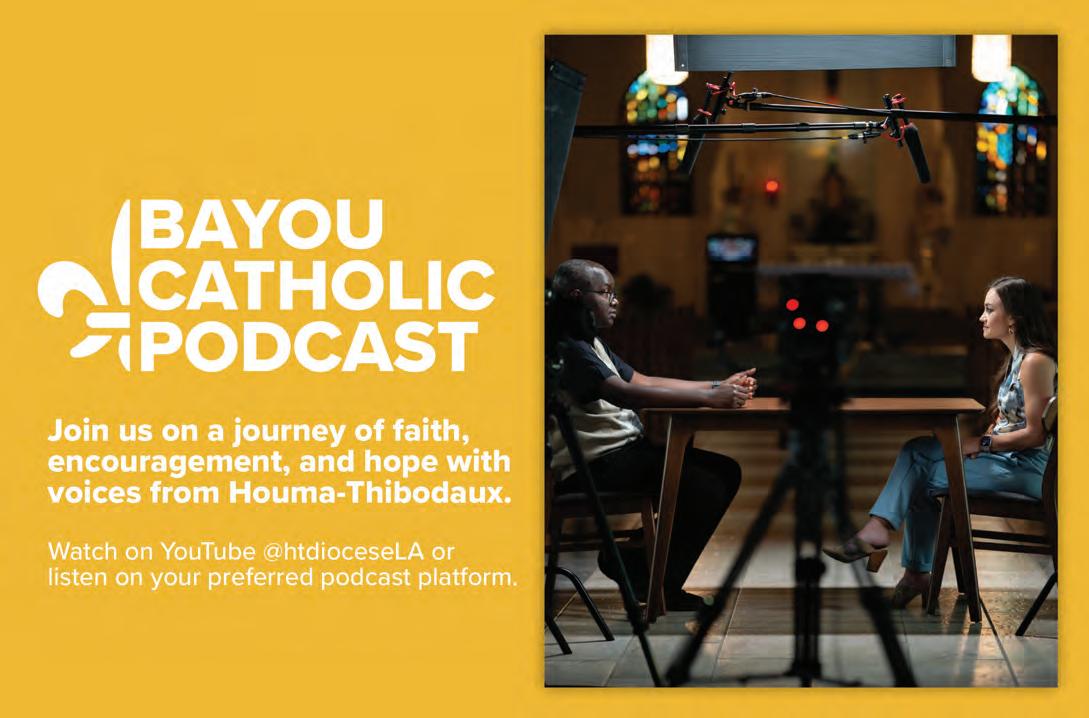



UPCOMING EVENTS
DIOCESAN MARRIAGE ANNIVERSARY MASS
Celebration of Sacramental Marriage: 25th, 40th, 50th, 60th+
Saturday, October 11, 2025
Mass at 10AM | Photos to Follow Mass Cathedral of St. Francis de Sales (Houma, LA)
MEMORIAL MASS OF ST. MARTIN DE PORRES
Celebrating National Black Catholic History Month
Saturday, November 8, 2025
Mass at 11AM | Reception to Follow St. Lucy Catholic Church (Houma, LA)
AMERICAN INDIAN MASS OF THANKSGIVING
Celebrating National American Indian Heritage Month
Friday, November 21, 2025
Mass at 6:30PM | Reception to Follow St. Charles Catholic Church (Pointe-aux-Chenes, LA)
FEAST OF OUR LADY OF GUADALUPE
Hispanic Cultural Mass
Friday, December 12, 2025
Mass at 7PM | Reception to Follow St. Joseph Co-Cathedral (Thibodaux, LA)
DIACONATE ORDINATION
Rev. Mr. Scott Beslin
Saturday, December 13, 2025
Mass at 10:30AM | Reception to Follow St. Joseph Co-Cathedral (Thibodaux, LA)
JUBILEE CLOSING MASS
Closing of the Jubilee Year of Hope
Sunday, December 28, 2025
Mass at 5:30PM
Cathedral of St. Francis de Sales (Houma, LA)
ADVERTISE WITH US
HAVE ANY FEEDBACK FOR THE BAYOU CATHOLIC?
Be a part of our magazine! The Bayou Catholic is always looking for valued partners. If you’re interested, reach out to us at communications@htdiocese.org.
We would love to hear from you! As we continue to improve this publication, we hope that you will help us along the way with constructive feedback. You can contact our team with feedback or suggestions at communications@htdiocese.org.
WRITE FOR THE BAYOU CATHOLIC
The Bayou Catholic is always adding voices to the magazine. If you’re interested in writing one of our columns, send us an email at communications@htdiocese.org.
INTERESTED IN WRITING FOR THE BAYOU CATHOLIC?
We are currently building our community of freelance writers. Reach out to our team at communications@htdiocese.org for consideration.
STORY IDEAS
We’d love to hear your ideas. Don’t hesitate to write to communications@htdiocese.org.
LOOKING TO ADVERTISE OR MAKE ANNOUNCEMENTS THROUGH THE PUBLICATION OR ONLINE AT BAYOUCATHOLIC.ORG?

communications@htdiocese.org to place an ad in the upcoming issues of the Bayou Catholic. To submit an announcement or news article, please reach out to us via email with copy and photos to support your article.
here! Join us on a journey of faith, encouragement, and hope featuring voices from the Diocese of HoumaThibodaux. Tune in on your favorite podcast platform.
Our team in the Communications Office for the Diocese of HoumaThibodaux is proud to produce this publication and we are grateful for your continued support.
FOLLOW US ON SOCIAL MEDIA
@htdiocese
@htdioceseLA Diocese of Houma-Thibodaux
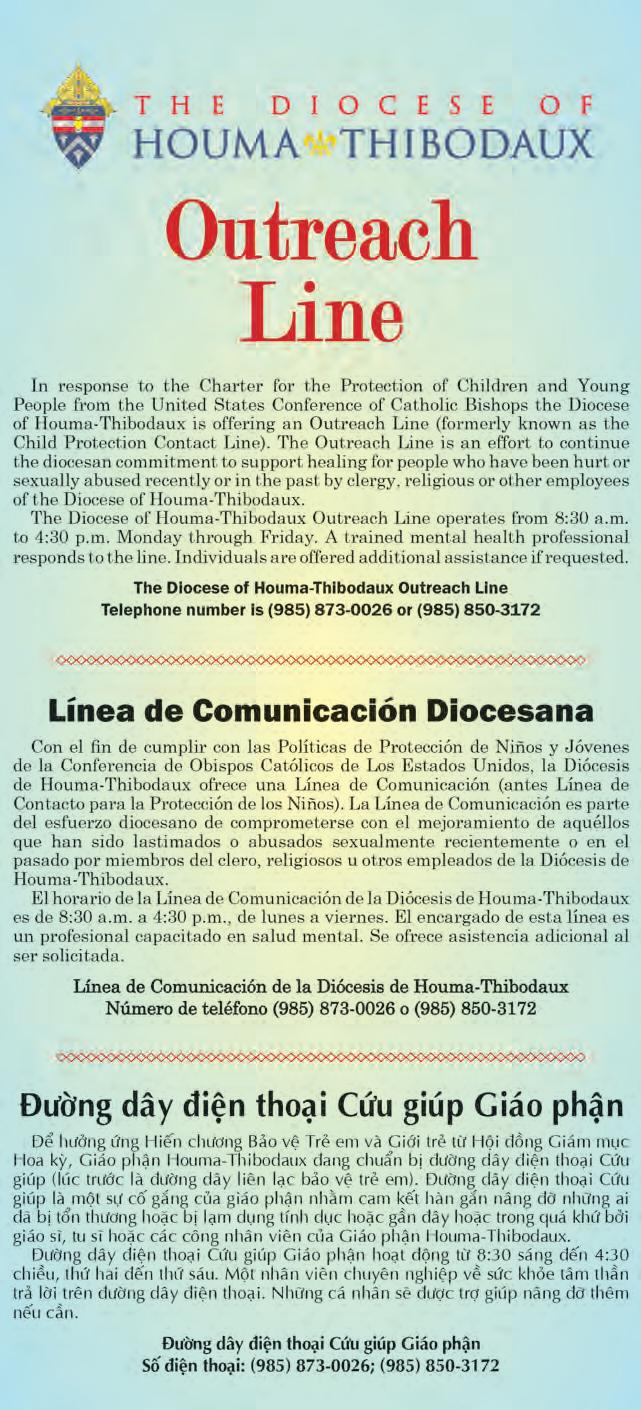


At Terrebonne General Health System, we believe that health is a journey best traveled together.
As your dedicated partner in wellness for over 70 years, we are committed to providing comprehensive, compassionate care tailored to your unique needs.
From preventive services, primary and specialty care, to advanced treatments, we offer a full spectrum of healthcare solutions to keep you and your family healthy.
Terrebonne is French for good earth, and Good Health here on the Good Earth sounds just right. Together, we can achieve a healthier, happier future.



HABEMUS EPISCOPUM!

We have a Bishop!
